Research & Innovation for Scholarly Excellence Grant Program
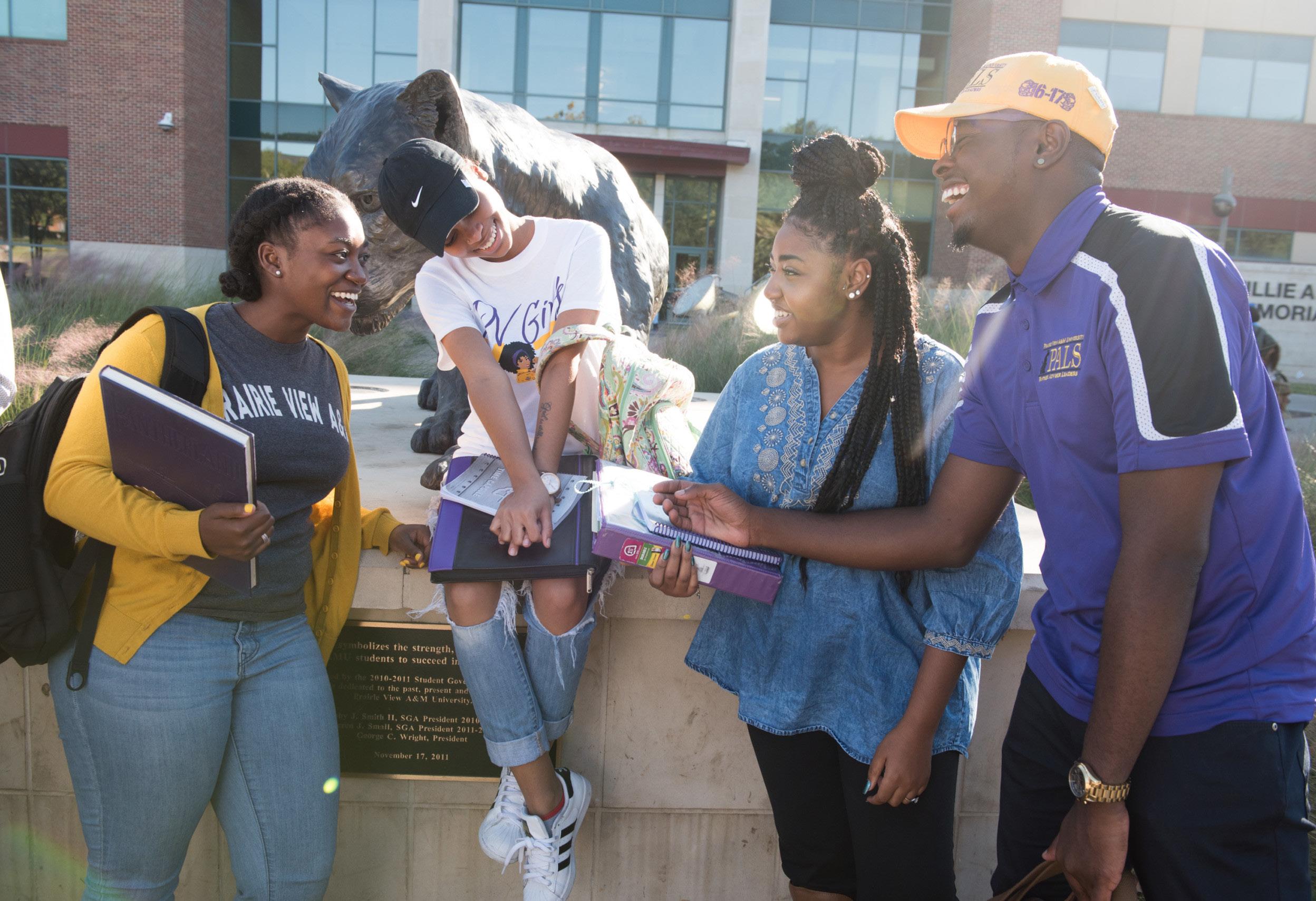
RESEARCH & INNO VA TIO N
Magesh T. Rajan, Ph.D., P.E., M.B.A. Vice President, Research & Innovation

The Division of Research & Innovation (R&I) is committed to advancing the research and innovation enterprise of PVAMU by supporting faculty-mentored undergraduate research, scholarship, and creative inquiry through the Faculty RISE-Undergraduate Research Grant Program. The program delivers students a full spectrum of opportunities and challenges to excel, academic reinforcement, networking, and diverse collaboration experiences.

R&I is pleased to present the research reports of the Faculty-RISE undergraduate students in this compendium. The faculty and staff worked together as collaborative interdisciplinary teams on diverse research projects. The research reports compiled in this booklet come from seven colleges and one school in the university.
R&I also proudly shares some of the successes of the RISE-Undergraduates this year: 58 showcased their research progress in the Student Research Day of the 2023 Research & Innovation Week organized in collaboration with the Conference for Interdisciplinary Student Research under the auspices of Texas Juvenile Crime Prevention Center at PVAMU. Over 100 students participated in the event and presented their research results. At this year’s TAMUS Pathways Symposium, more than 30 students participated and one undergraduate and three graduate RISE students won awards.
With this annual Faculty RISE-Undergraduate Research Report, R&I recognizes and celebrates the research accomplishments of our undergraduate students.
2

Table of Contents Agriculture and Human Sciences ......................................................................................................................... 5 Evaluation of SMAP soil moisture data in West Texas using measured data from West Texas Mesonet ................. 5 Architecture 7 Hands-On Preservation Experience (HOPE Crew): Utilizing Graphic Design and UX for the Preservation of Historic African-American Burial Sites 7 Arts and Sciences .................................................................................................................................................. 11 ImageJ Assessment of Pneumococcal Keratitis Damage in a New Zealand Rabbit Keratitis Model 11 Identification and Extraction of Pesticides in Strawberrie s 14 Synthesis and characterization of CuS nanoparticles deposited over graphene nanosheets ................................ .. 16 Synthesis and primary characterization of Transition Metal Complexes of 18 Ethylenediamine-bis-4-hydroxy-3-methoxybenzaldehyde 18 Measurement of Hystere sis Curves in Soft Magnetic Materials 21 Computer Science ............................................................................................................................................... 24 Smart irrigation IoT Project 24 Education ............................................................................................................................................................ 28 TexSTEM: Producing PV STEM Teachers 28 Evaluating the Influence of Identity on Perceptions of Mental Health, Exercise, and Sport Among Collegiate Students 31 Assessing the Inclusion of Universal Design for Learning (UDL) in Higher Education Institutions Curriculum 34 The Promotion of Women at Historically Black Colleges a nd Universities as it Relates to the Imposter Phenomenon 35 Engineering ........................................................................................................................................................ 38 Lipase-Catalyzed Hydrolysis of Triglycerides from Yellow Nutsedge Tubers and Seeds of Switchgrass 38 Network Traffic based Ransomware Detection at an Early Stage 42 Engaging Undergraduate Researchers in Developing Automatic Data Analysis Tools ................................ ......... 45 Using Nanomaterials for X-ray Radiation Sensing Devices 48 Towards a Robot that can Play Slide Puzzle Games 50 Modeling of Atherosclerosis Pathogenesis 53 -Caprolactone) Nanofibers 56 RESEARCH & INNO VA TIO N
Juvenile Justice and Psychology......................................................................................................................... 60 Accessing African Centered Cultural Programs in English Prisons ................................ ................................ ....... 60 Medical Academy ............................................................................................................................................... 64 Development of Biodegradable and Biocompatible polymer-based scaffolds for Tissue Engineering ................... 64 Nursing ............................................................................................................................................................... 67 The Relationships Among Child Sexual Abuse, Psychosocial Outcomes, and Mental Health Burden: A Literature Review 67 RESEARCH & INNO VA TIO N
Agriculture and Human Sciences
Evaluation of SMAP soil moisture data in West Texas using measured data from West Texas Mesonet
Ehiguese Obiomon and Ripendra Awal*
Department of Agriculture and Nutrition, College of Agriculture and Human Sciences
Introduction:
Soil moisture has a critical role in controlling the water balance of a catchment by influencing rainfall-runoff processes, infiltration, groundwater recharge, and evapotranspiration. Also, timely soil moisture information is required for drought monitoring, flood forecasting, and understanding vegetation dynamics. The two most prominent soil moisture measurement methods are the in-situ and satellite-based remote sensing methods. The in-situ collection method uses stations spread over a certain area (e.g., agricultural fields) to record soil moisture. In-situ measurements have high accuracy, but the spatial coverage is challenging. In addition, the installed sensors may require extensive maintenance. Satellite-based remote sensing is an excellent alternative to in-situ measurement when soil moisture data is needed for a large area or when soil moisture data is required for an area without any in-situ measurement methods. The most utilized satellite-based remote sensing method is the Soil Moisture Active Passive (SMAP). SMAP is NASA's Earth satellite mission designed to measure and map Earth's soil moisture (Chan et al., 2016). The SMAP sends radar radio waves down to a spot on Earth and measures the echo that returns a few microseconds later. The strength and shape of the echoes indicate the soil's moisture level. SMAP collects and records soil moisture data in a 9km grid. This project focuses on finding how accurate the SMAP soil data is. To do this, we compared the SMAP soil moisture values with the in-situ soil moisture values. Because SMAP records soil moisture in a 9km grid, we had to interpolate the West Texas Mesonet (WTM) data to a 9 km grid. Interpolation of the in-situ data separates this project from similar previous studies. Many studies have compared in-situ data against SMAP data, but they have yet to implement interpolating the in-situ data in Texas. This study aimed to compare grid-interpolated observed soil moisture obtained from WTM with SMAP values to determine the accuracy of SMAP soil moisture products.
Materials and Methods:
The SMAP soil moisture data is collected from CROP CASMA (Condition and Soil Moisture Analytics), a web-based geospatial application designed for users to utilize the remotely sensed geospatial soil moisture and vegetation index. Crop CASMA derives data from NASA SMAP and MODIS missions to assess conterminous U.S. crop vegetation and soil moisture conditions. NASA and USDA-NASS fund this application. It was designed and developed by USDA-NASS and the Center for Spatial Information Science and Systems at George Mason University. The SMAP and WTM products are downloaded for the topsoil, representing the top 5 cm depth. For this project specifically, we collected the SMAP data for the entire state of Texas in a raster file.
5
The in-situ soil moisture data is collected from the West Texas Mesonet. The West Texas Mesonet, or WTM, provides weather and soil moisture data for the Panhandle and other areas of West Texas. Four different interpolation techniques were used: Inverse Distance Weightage (IDW), Kriging, Natural Neighbor (NN), and Spline . After interpolating the WTM data, we used the Zonal Statistics function of ArcGIS to assign average soil moisture values to every 9km grid of the study area. We used the software R Studio to compare the SMAP and interpolated WTM data. RStudio is an integrated development environment for R, a programming language for statistical computing and graphics. Using R Studio allowed us to visually and mathematically compare the SMAP and interpolated WTM data. We decided to cluster the data after preliminary research. We clustered the 89 stations into four groups using the K-Nearest Neighbor Clustering function on ArcGIS. We then used the same process as for the whole WTM for each individual cluster of WTM stations.
Our previous analysis only used ten days of data. Observed soil moisture data from WTM were soil moisture at midnight and did not average for the entire day. However, a long-term analysis is required for calibrating the statistical models developed for comparing SMAP and WTM datasets. Therefore, we collected SMAP soil moisture for the period 05/01/2022 – 08/24/2022.
We also collected 15-minute interval soil moisture data from West Texas Mesonet for the same period. The data collected from 142 stations are in HTML format and need to extract daily averaged data for interpolation in soil moisture grids. The downloaded HTML data will be extracted using R/Python packages for further analysis.
Results and Discussion:
In our previous analysis, IDW and kriging showed the highest correlation with an r-value of 0.55. The lowest correlation coefficient was that of Spline, with an r-value of 0.46. The WTM data were classified into different clusters to improve the correlation with the SMAP data and quantify the region which shows the highest correlation with the SMAP product. We found that 4 clusters best fitted the WTM stations. The results showed that clusters 1 and 4 correlate well with the SMAP data, whereas clusters 2 and 3 showed less correlation in the analysis.
We will analyze collected and processed data to confirm our previous findings. We will also use Artificial Intelligence Techniques, e.g., Random Forest and ANN-based interpolations .
References:
Chan, S. K., Bindlish, R., O'Neill, P. E., Njoku, E., Jackson, T., Colliander, A., ... & Kerr, Y. (2016). Assessment of the SMAP passive soil moisture product. IEEE Transactions on Geoscience and Remote Sensing, 54(8), 4994-5007.
6
Architecture
Hands-On Preservation Experience (HOPE Crew): Utilizing Graphic Design and UX for the Preservation of Historic African-American Burial Sites
Aliya Beechum and Jessica A. Ward*
Department of Architecture, College of Architecture
Introduction:
Research Path: Prairie View A&M University Palimpsest Mapping and Cemetery
Documentation
The researcher will explore the specific historic lines of flight that connect to the cemetery and burial ground on campus to previous and ongoing research work, including ground penetrating radar results from 2022 and historic maps. The researcher will develop a plan to record and preserve headstones and family histories throughout time, while establishing that timeline with a preliminary plan to make information accessible on a central website location in the cloud. The fall hands-on experience will include observation and use of drone scanning of the selected historic cemetery site, funded through the National Trust for Historic Preservation. The researcher will explore the preservation needs of these historic landscape sites on campus and help craft a digital/ virtual learning experience for visitors of the sites that will help address the cemetery site's needs that may also include; helping to establish future walking paths, traditional cemetery preservation needs such as headstone cleaning or resetting, vegetation removal, and other site maintenance needs such as fencing and removal of debris.
SITE DESCRIPTION & BACKGROUND
Wyatt Chapel Community Cemetery is located on Prairie View A&M campus. It has 2 sections, 1 modern section east of Wyatt Chapel Rd and 1 section north of Williams Street (along Ponds Creek). The north section might contain the graves of over 2,000 former slaves. While the cemetery contains only a handful of marked graves, we have recently discovered a host of death certificates that prove the cemetery contains veterans of World Wars I and II. As time went on the cemetery became abandoned in the early 1950s.
PROJECT DESCRIPTION
This opportunity will give 10-12 AIAS/ SOA architecture and digital media undergraduate/ graduate students to work in teams of 2 on conceptual designs for non-invasive signage for the sacred space. This project will include cemetery Signage Design, Digital Documentation through LiDAR Mapping of marked and unmarked grave areas, and a website to host the digital maps and wayfinding designs. It will also include fabrication in the School of Architecture Fabrication Center of park-like signage prototypes to be presented to a committee of campus professors, campus planning and families for further development and incorporation into the final plans.
7
The RISE undergraduate research assistant will assist the Historic Trust HOPE Crew Fellow, a graduate architecture student, by building/ creating a historically sensitive digital website space to host the project maps, designs and connect/ link visitors of the site to the Digital PV Panther Project Special Collections & Archives Department in the Coleman Library. This work will support the HOPE Crew grants and the current archival work and ground penetrating radar research currently being funded in the unmarked burial ground area by the National Endowment for the Humanities.
Objectives/goals:
1. Through a series of 6 scheduled workshops, photogrammetry and design meetings, the RISE UG will Assist the Digital Documentation Fellow for the National Trust for Historic Preservation HOPE Crew to develop an online wayfinding system for the Wyatt Chapel Cemetery and unmarked burial ground. This will include:
a. An online web style guide that dictates the official visual aesthetic of the landing page, and navigation to palimpsest mapping done by the architecture and digital media arts students, and to the PVAMU digital archives. Researching the best online platform for the project and developing high quality digital standards of graphic display.
b. Develop a QR code that can be replicated on fabricated signage prototypes that links visitors to the online digital resources from the site.
c. Researching and working with design professionals on Virtual Reality options to augment the wayfinding designs with history and community-based storytelling.
d. Assist the HOPE Crew participants in creating signage, wayfinding guidelines and graphics that reflect the sacred nature of the site and help visitors uncover and unlock the complex history while navigating the landscape. The digital spaces will serve as a virtual gateway into these layers of storytelling, preservation, and racial reconciliation.
Materials and Methods:
1. PVAMU Digital Media Arts Creative Thinking Process (empirical approach): Involves using a 5-step empirical approach to solving design problems, which in this case is creating and designing digital spaces for historic preservation. The 5-steps are: 1. Define the Problem, 2. Research, 3. Ideation, 4. Prototype, and 5. Implement.
2. Participatory Design (commonly referred to a User-Centered Design): Involves the enduser(s) to be engaged in the Creative Thinking Process in an effort to produce the digital space that is most appropriate to the culture and concerns of the intended audience.
Results and Discussion:
The RISE Fellow completed significant additional research, which included document research in the PVAMU and the City of Prairie View Library Archives, meeting with stakeholders, and capturing the events of the workshops through participation. The result of uncovering additional historic documentation was a commemorative booklet and timeline, in addition to an online style guide for future use. The Design Book is a quick guide that contains research findings, maps,
8
photographs and QR codes to additional resources. One of the QR codes will take readers to the documentary produced by the National Trust for HIstoric Preservation HOPE Crew program. The documentary facilitated by our team, showcases this research on Prairie View’s campus.
This will be the first design book of its kind to be produced by our School of Architecture on the history of the cemetery on campus. Due to our findings, it is hypothesized that the cemetery site may be larger than previously believed. Those areas of interest are outlined in green in the Palimpsest map in the Design Book. Research recommendations are on the final page of the booklet, “Preservation for the Future”. This will also include a link to the research Fellow’s appendix and references (expanded from below).
Additionally, Funded by the National Trust for Historic Preservation HOPE Crew Program, Texas Cemetery Restoration documented the headstone locations and inscriptions of the PVAMU Community Cemetery site in September 2022 using drone technology and photography. The map and database of burial locations and headstone information was generated for the Prairie View A&M University archives and future campus master planning.
Missing and broken headstones on the Wyatt Chapel Cemetery site are in need of repair and replacement. Existing headstones in this area need immediate protection. Illegal dumping at the road bridge needs to be cleaned and consideration to the closing of the bridge should be given. Wayfinding signage that extends to a campus wide trail that creates a remembrance path, including unmapped underground areas on campus and environmental testing west of the cemetery sites is recommended.
Impact/Significance:
Guest Professor Dr. Melayne Price and Dr. Ward will use the Design Book as an attachment and stepping stone when applying for future grant funding with the National Trust for Historic Preservation. I am also looking at submitting a session that showcases this research to the 2024 Texas Historical Commission's Real Places Conference in Austin, Texas.
References:
1. Abras, C., Maloney-Krichmar, D., Preece, J. User-Centered Design. Encyclopedia of Human-Computer Interaction. Thousand Oaks: Sage Publications.
2. Bennett, A., Eglash, R., Krishnamoorthy, M., Rarieya, M. Audience as Co-designer: Participatory Design of HIV/AIDS Awareness and Prevention Posters in Kenya. Design Studies: Theory and Research in Graphic Design, A Reader. Princeton Architectural Press, 2006. Pgs 179–197
3. Evenson, Shelley. Directed Storytelling: Interpreting Experience for Design. Design Studies: Theory and Research in Graphic Design, A Reader. Princeton Architectural Press, 2006. Pgs 231–240.
4. Fly, Everette. African American Cemeteries: National Challenges. April 9, 2017, accessed online 2022; https://everettfly.com/african-american-cemeteries-nationalchallenges/
9
5. LeCompte, Margaret D., Schensul, J. Designing and Conducting Ethnographic Research: An Introduction (Ethnographer’s Toolkit, Second Edition). AltaMira Press; Second Edition. 2010.
6. Lipton, Ronnie. Designing Across Cultures. HOW Books. 2002.
7. Price, Melanye Dr. I See U, Episode 25: Troublesome Legacies. Nov. 11, 2021, accessed online 2022; https://www.houstonpublicmedia.org/articles/shows/i-seeu/2021/11/11/413200/i-see-u-episode-25-troubl esome-legacies/
8. Schuler, Douglas, Namioka, A. Participatory Design: Principles and Practices. CRC Press. 2017.
10
Arts and Sciences
ImageJ Assessment of Pneumococcal Keratitis Damage in a New Zealand Rabbit Keratitis Model
Siah Green1and Quincy C. Moore III*
Department of Biology, College of Arts and Sciences
Introduction:
Streptococcus pneumoniae is an important cause of bacterial keratitis, an infectious disease of the cornea. Bacterial keratitis is a devastating infection of the cornea that can lead to corneal scarring and vision loss (Wagoner et al. 2007). Streptococcus pneumoniae keratitis frequently follows surgery or trauma to the eye and is more common in patients with coexisting ocular disease (Bharathi et al. 2007). Traditionally, pneumococcal infections affect primarily elderly individuals or young children due to their weakened immune systems (Robinson et al., 2001). Our laboratory recently developed the mouse model of pneumococcal keratitis which will allow the elucidation of the host factors directly involved in the host response, especially regarding innate immunity (Moore et al., 2009). The ImageJ Application is being used to measure the diameter of the infection site from Day 1 to Day 5 to view the progression and growth of it. A widely used alternative to the commercially available Photoshop program is ImageJ, a publicdomain Java-based image processing and analysis program developed by Wayne Rasband of the National Institute of Mental Health at NIH (Rasband, 1997; Schneider et al. 2012). ImageJ has been extensively used for image processing in immunohistochemistry (Schneider et al. 2012), tissue segmentation in microscopy images (Collins, 2007), and muscle morphometric measurements (Fortin & Battié, 2012). The purpose of this study is to develop an accurate procedure to determine the impact of Bacterial Keratitis on the eye.
Objectives/goals:
The analysis of the keratitis infection with ImageJ should provide a more detailed evaluation of the ocular damage and render an alternative tool for assessing the ocular damage. Using ImageJ different inputs and plugins, the study will provide the best way to visualize the effects of this bacteria on the eye. The goal of the study is to seek to provide a tool that will analyze the damage done to a rabbit’s cornea beneath the surface layer.
Materials and Methods:
This study observed the processing of viewed areas of infection by Streptococcus pneumoniae keratitis by ImageJ through 3D modeling and Plot Graphing. Through these efforts of trial and error with ImageJ, the study was able to discover new ways to utilize the software for more detailed visualization of biological models. Discoveries from this software provided different
11
perspectives of how invasive keratitis infections can impact the cornea. ImageJ is a public Javabased image processing and analysis program inspired by the National Institute of Mental Health available for Windows, Macs, and Linux. ImageJ was used to create display the impact of infection and analysis for the ocular images. The program can easily adapt to required tasks in laboratories and in research.
Infection profiles consist of isolation of the infectious zone based on the presence of the disease in the ocular environment. 3D image of keratitis infection (displaying the depth of infection), Plot Graphs (displaying metric impact of infection). Each image is an assessment of a different rabbit ocular samples obtained from research studies in the Marquart lab (Univ. of MS Medical Center, Jackson, MS).
Results and Discussion:
The analysis of the keratitis infection with ImageJ provided a more detailed evaluation of the ocular damage and rendered an alternative tool for assessing the ocular damage. The goal of the study was to seek to provide a tool that will analyze the damage done to a rabbit’s cornea beneath the surface layer. The outcomes of the study proved ImageJ’s ability to render a possible alternative research option for animals and provide a library of detailed analyses of ocular damage related to bacterial keratitis. Use of animals cannot be completely removed due to the lack of real time responses that cannot be generated with a computer model thus the use of ImageJ analysis will further substantiate an animal study. Further analysis with ImageJ with this study has continued to provide a more detailed evaluation of the ocular damage and has rendered an alternative tool for assessing the ocular damage. The goal of the study is to seek to provide a tool that will analyze the damage in a rabbit’s cornea beneath the surface layer. The project continues to utilize ImageJ’s ability to offer alternative research for animals and provide a library of detailed analyses that can further animal related studies.

 Figure 2. 24 hours following the Keratitis infection, an photograph of the ocular surface revealed the presence of infective infiltrate. For analysis purposes of the ocular infection, the area in question was magnified and ImageJ allowed for direct focus and emphasis on the infective area.
Figure 2. 24 hours following the Keratitis infection, an photograph of the ocular surface revealed the presence of infective infiltrate. For analysis purposes of the ocular infection, the area in question was magnified and ImageJ allowed for direct focus and emphasis on the infective area.
12
Figure 3. 17.82% of cornea infection. Figure 4. 19.77% of cornea infection. Figure 5. 32.94% of cornea infection
Infection profiles: a) 3D image of keratitis infection (displaying the depth of infection), b) Plot Graphs (displaying metric impact of infection) Colored asterisks (*) correspond to peaks in graphs.
Impact/Significance:
This study evaluated Pneumococcal keratitis caused by Streptococcus pneumoniae and the serious implications of the corneal infection in the various ocular samples in the rabbit model. S. pneumoniae is a gram-positive bacterium with over ninety different capsular serotypes and is responsible for varying pneumococcal diseases such as keratitis. This analysis included producing 3D imaging and plot graphs from various perspectives providing a greater understanding of the depth of the infected areas. The 3D imagery analysis revealed various levels of the corneal infection. It was not localized among the images and was not localized to a particular region of the eye. The construction of the 3-dimensional image revealed the infection penetrates beyond the epithelial layer of the cornea and went into Bowman's layer and the stroma. This study’s perspective is beneficial because on the eye from this bacterium ranging from resolving after prompt treatment to serious and threatening one’s quality of vision. In this study, the infectious potential of the bacteria has been further analyzed and provides further evidence of the need for prompt treatments when such infections are discovered.
References:
1. Wagoner MD, Al-Ghamdi AH, Al-Rajhi AA. Bacterial keratitis after primary pediatric penetrating keratoplasty. Am J Ophthalmol. 2007; 143:1045–1047
2. Bharathi MJ, Ramakrishnan R, Meenakshi R, Padmavathy S, Shivakumar C, et al. Microbial keratitis in South India: influence of risk factors, climate, and geographical variation. Ophthalmic Epidemiol.2007; 14:61–69.
3. Robinson KA, Baughman W, Rothrock G, Barrett NL, Pass M, et al. Epidemiology of invasive Streptococcus pneumoniae infections in the United States, 1995–1998: Opportunities for prevention in the conjugate vaccine era. JAMA. 2001:1729–1735.
4. Moore QC, 3rd, McCormick CC, Norcross EW, Onwubiko C, Sanders ME, et al. Development of a Streptococcus pneumoniae Keratitis Model in Mice. Ophthalmic Res. 2009; 42:141–146.
5. Rasband WS. ImageJ. Bethesda: US National Institutes of Health; 1997.
6. Schneider, Rasband & Eliceiri (2012) Schneider CA, Rasband WS, Eliceiri KW. NIH Image to ImageJ: 25 years of image analysis. Nature Methods. 2012; 9:671–675. doi: 10.1038/nmeth.2089
13
Identification and Extraction of Pesticides in Strawberries
D’ Aheja Gillis and Harschia Fernando*
Department of Chemistry and Physics, College of Arts and Sciences
Introduction:
Two common strawberry fungicides have been found to affect cellular mechanisms, resulting in subdued flavor and sweetness, as well as lower nutritional value in berries. Strawberry pesticide content exceeds 43% of pyraclostrobin, a toxin for bees, and 42% of captan, which can cause cytotoxicity and regenerative cell hyperplasia at prolonged high levels. Pesticide residues are found on nearly 75 percent of non-organic fresh produce sold in the U.S., according to the EWG's 2023 Shopper's Guide to Pesticides in ProduceTM. The human body is vulnerable to multiple types of harm from pesticide exposure. These findings are especially concerning for children, who are especially vulnerable to pesticides and associated health problems. Based on the latest Department of Agriculture and Food and Drug Administration (USDA) fruit and vegetable testing data, EWG has created the Shopper's Guide. The 2023 guide includes data from 46,569 samples of 46 fruits and vegetables. Prior to testing, USDA samples are peeled, scrubbed, and washed, while FDA samples are simply cleaned. It still turns out that 251 different pesticides are present in the samples after the tests have been conducted. Pesticides have been linked to health issues in numerous peer-reviewed scientific studies. Pesticide mixtures found on produce raise serious safety concerns. In a Harvard University study, it is reported that high levels of pesticide residue on fruits and vegetables may reduce their benefits, including protection against cardiovascular disease and mortality. There were 103 pesticides detected in kale, collard greens, and hot peppers, as well as 101 pesticides in bell peppers and hot peppers. 6% of green bean samples were found to contain the neurotoxic organophosphate insecticide acephate, which was banned in 2011.
Objectives/goals:
The objective of the project is to quantitatively analyze strawberry pesticides using high performance liquid chromatography (HPLC) using a simple but highly effective method.
Materials and Methods:
Ten g sample of strawberries was placed in a 50mL centrifuge tube, and 5mL of water was added to the tube. Once the tube had been vortexed for a minute, 10 mL of acetonitrile (ACN) was added and vertexing lasted 30 seconds. Hand shake the sample tube for 1 minute using the QuEChERS dispersive kit EN extraction packet (5982-6550). A 15-minute centrifugation at 4000 rpm followed. Bond Elut EN dispersive SPE mL tubes are filled with 6 mL of upper ACN layer. After vertexing for 1 minute, the tube is centrifuged again for 15 minutes at 4000 rpm. Using a nitrogen stream (85 degrees Celsius), the collected ACN layer was dried. Re-dissolved residue was then transferred to a 5 mL Eppendorf tube with 1 mL ACN . Prior to separation by HPLC, solvents are filtered through PTEE millipores of 0.45mm. For HPLC, the following conditions were used: Flow rate: 0.240 mL/min, injection volume: 10 uL, temperature: 28°C, UV detection: 280 nm, mobile phases: MeOH (40%) and H20 (60%). The solvents were analyzed for 45 minutes using this apparatus.
14
Results and Discussion:
HPLC results for the pesticide standard and a representative sample run is given below. According to preliminary data from the strawberry sample and the standard, there may be peaks associated with pesticides. The HPLC profiles of the sample and the standard did not match exactly. Detail analysis using mass spectrometry coupled to the HPLC system will lead to a clear confirmation of the pesticides. For better statistical significance, more samples need to tested.

HPLC profile of the standard HPLC profile of the sample
Impact/Significance:
Food safety is an important topic. The common contaminants present are pesticides, polycyclic aromatic hydrocarbons and sterols. Research on this topic once established will enable us to identify the contaminants present in different types of food.
References:
1. Group, Environmental Working. “EWG’s 2023 Shopper’s Guide to Pesticides in ProduceTM.” EWG’s 2023 Shopper’s Guide to Pesticides in Produce | Summary, www.ewg.org/foodnews/summary.php. Accessed 13 July 2023. Author links open overlay panel
2. M.C Alonso a, et al. “Determination of Priority Phenolic Compounds in Soil Samples by Various Extraction Methods Followed by Liquid Chromatography–Atmospheric Pressure Chemical Ionisation Mass Spectrometry.” Journal of Chromatography A, 2 Dec. 1998, www.sciencedirect.com/science/article/abs/pii/S0021967398001101. Analysis of Pesticide
3. Residues in Apple Using Agilent Bond Elut … www.agilent.com/Library/applications/59904073EN.pdf. Accessed 13 July 2023.
15
Synthesis and characterization of CuS nanoparticles deposited over graphene
nanosheets
Paris Semien, Maci Guy and Gururaj M Neelgund*
Department of Chemistry and Physics, College of Arts and Sciences
Introduction:
The employment of near-infrared (NIR) radiations in photothermal therapy (PTT) to treat cancer is current high-pitched interest aside from its classical applications such as telecommunication, sensing ablation etc [1]. The reason is that NIR region (700-1100 nm) is ideal clinical phototherapeutic window for PTT as attenuation of NIR radiations by skin, blood and tissues is low and it allow for the treatment of deep-seated tumors. [2]. The application of PTT in the treatment of tumors has been identified as a minimally invasive alternative to conventional hyperthermia treatment owing to its remote controllability, low systemic toxicity, and minor side effects [3]. While, the implementation of PTT relies on the development of suitable photothermal coupling agents. On account of importance of photothermal agents in PTT, herein we designed the robust NIR active agent, GR-CuS by deposition of CuS nanoparticles over graphene (GR) nanosheets.
Materials and Methods:
Preparation of GR-CuS: Graphene oxide (GO) needed to produce GR nanosheets was obtained by Hummers and Offeman method with slight modifications [4,5]. 1 g of graphite powder (<20 μm, Aldrich) was added to 40 mL concentrated H2SO4 and stirred for 1 h under ice-cooling condition. Then, 15 mL fuming HNO3 was slowly added and stirred the mixture for 30 min. To this, 5 g of KMnO4 was gradually added with stirring and cooling and the resulting mixture was stirred at room temperature for 12 h followed by addition of 150 mL DI water. After stirring the mixture for 30 mins, 30 mL of H2O2 (30%) was slowly added, which turned the color of the reaction mixture to bright yellow. The resulted mixture was centrifuged and washed with 1:10 HCl in water solution in order to remove metal ions. Further, the mixture was washed with DI water until complete removal of the acids and thus obtained dark- yellow colored GO was dried under vacuum at 40 °C for 12 h. The drying process of GO was carried out at lower temperature in order to avoid its deoxygenation. Then GO (50 mg) was dispersed in EtOH (50 mL) by sonication for 5 mins, subjected to centrifugation and EtOH was removed. Then GO was redispersed in ethylenediamine (EDA) to yield the yellow-brown suspension, which was subjected to refluxing for 1 hr at 80 C. The resulting black suspension of GR nanosheets was then centrifuged, subsequently washed with EtOH and DI water and dried under vacuum at 40C for 5h. Subsequently, 100 mg GR nanosheets was dispersed in 50 mL DI water by sonication and 20 mL aqueous solutions of CuCl2 (0.01 mol) and Na2S (0.01 mol) was added to it. The resulting mixture was allowed to stir for 4 hr at room temperature to yield GR-CuS.
Results and Discussion:
16
The prepared GR-CuS will be characterized using various instrumentation viz., IR, UV-vis-NIR, XRD, SEM, TEM, Raman, EDX and XPS. The photothermal effect of GR-CuS will be estimated by exposing its aqueous dispersion to 980 nm laser system and monitored its rise in temperature.
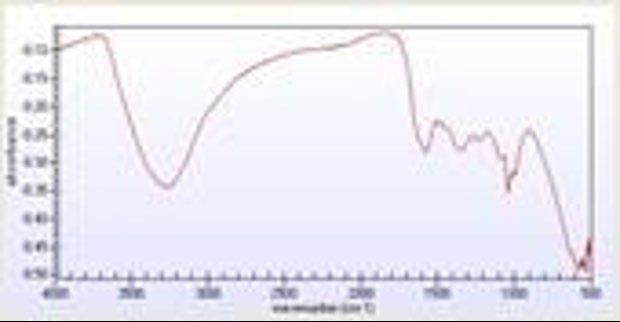
Conclusion:
The robust NIR active agent, GR-CuS has been successfully prepared. The characterization of GR-CuS was performed using different instruments.

References:
1. Q. Tian, F. Jiang, R. Zou, Q. Liu, Z. Chen, M. Zhu, S. Yang, J. Wang, J.Wang, J.
2. Hu, ACS Nano 5 (2011) 9761–9771.
3. R.A. Weissleder, Nat. Biotechnol. 19 (2001) 316-317.
4. D. Lane, Nature Biotechnol. 24 (2006) 163-164.
5. W.S. Hummers, R.E. Offeman, J. Am. Chem. Soc.80 (1958) 1339.
6. G. M. Neelgund, V. N. Bliznyuk, A. Oki, Appl. Catal. B 187 (2016) 357–366.
Fig. 1. ATR- IR spectrum of GR.
Fig. 2. ATR- IR spectrum of GR-CuS.
17
Synthesis and primary characterization of Transition Metal Complexes of Ethylenediamine-bis-4-hydroxy-3-methoxybenzaldehyde
Kennedy Barlow and Gina Chiarella*
Department of Chemistry and Physics, College of Arts and sciences
Introduction:
Schiff bases or azomethines are compounds with a general chemical structure of a doublebonded carbon and nitrogen with a lone electron pair attached to the nitrogen The presence of electron donor atoms (N and O) in their structure, make them excellent ligands for preparation of metal complexes. Because of their similarities with the enzymes’ active centers, Schiff bases are used to prepare environmentally friendly products, with catalytic, medicinal, and pharmaceutical applications. The goal of this research is to prepare and characterize Schiff bases ligands prepared from vanillin, ortho vanillin, and ethylenediamine. The Schiff base ligands are then used to prepare transition metal complexes with first row transition metals. The current research with the vanillin ethylenediamine ligand has been done using Copper (II) Chloride, Nickel (II) Chloride, Manganese (II) Chloride, Copper (II) Sulfate, Nickel (II) Acetate and Zinc (II) Acetate. Using ortho vanillin and ethylenediamine to make the ligand, transition metal complexes with Copper (II) Acetate and Nickel (II) Acetate have been formed. The transition metal complex with Copper (II) Sulfate is also used for crystallization.
Materials and Methods:
Project 1: Synthesis of Bis-4-hydroxy-3-methoxybenzaldehyde ethylenediamine ligand and Bis4-hydroxy-3-methoxybenzaldehyde ethylenediamine ligand/ metal complexes
The Schiff base was synthesized by mixing 4-Hydroxy-3-methoxybenzaldehyde with ethylenediamine (molar ratio 2:1) in ethanol solution at room temperature. The complexes were prepared by addition of the metal-chloride salt to an ethanol solution of the Schiff base in (molar ratio ligand/metal of 2:1), stirring at room temperature for several minutes until the color of the solution changed. UV-visible and FTIR spectroscopy was used to do the primary characterization of the ligand and the two complexes. Schiff bases were also synthesized by combining a metal complex dissolved in methanol and ligand dissolved in acetonitrile (molar ratio ligand/metal of 2:1). The synthesis of Schiff base also occurred in a molar ratio of 1:1 (ligand/metal) and was refluxed.
Project 2: Preparation of CuSO4- ligand for crystallization
A solubility test with multiple solvents was performed first using the ligand-transition metal complex. Complex was soluble in H2O and slightly soluble in acetonitrile and methanol. For crystallization, the transition metal complex and H2O were combined and added into a tube and placed in a vial. In the vial surrounding the tube, methanol was added so that the vial-in-vial vapor diffusion method was used
18
Project 3: Synthesis of 2-hydroxy-3-methoxybenzaldehyde ethylenediamine ligand and 2hydroxy-3-methoxybenzaldehyde ethylenediamine ligand/ metal complexes
The Schiff base was synthesized by dissolving o-vanillin (2-hydroxy-3-methoxybenzaldehyde) in ethanol and combining with ethylenediamine (molar ratio 2:1). Solution was stirred and refluxed for three hours and left overnight. The next day, the solution was filtered to collect the precipitate, left to dry, then collected and stored in a vial. This ligand was then used to make two metal complexes with Copper (II) Acetate and Nickel (II) Acetate in a 2:1 molar ratio and the same stirring and refluxing method in an ethanol solution. UV-visible and FTIR spectroscopy was used to do the primary characterization of the ligand and the two complexes.
Results and Discussion:
A number of complexes were synthesized throughout three different projects. IR spectroscopy and UV spectroscopy were used to prove the formation of new products. This is proved by the varying peaks seen on the IR and UV results. Peaks from the various metal complexes are different from the ligand in some ways. That proves that a new complex was formed. There are some peaks that are common among both the ligand and the transition-metal complexes. This shows that there are some similarities between the two, proving that the starting ligand is present in the complexes that were synthesized. The complexes that were set up for crystallization were successful in forming crystals. More testing needs to be done on the crystals formed to know more about their composition
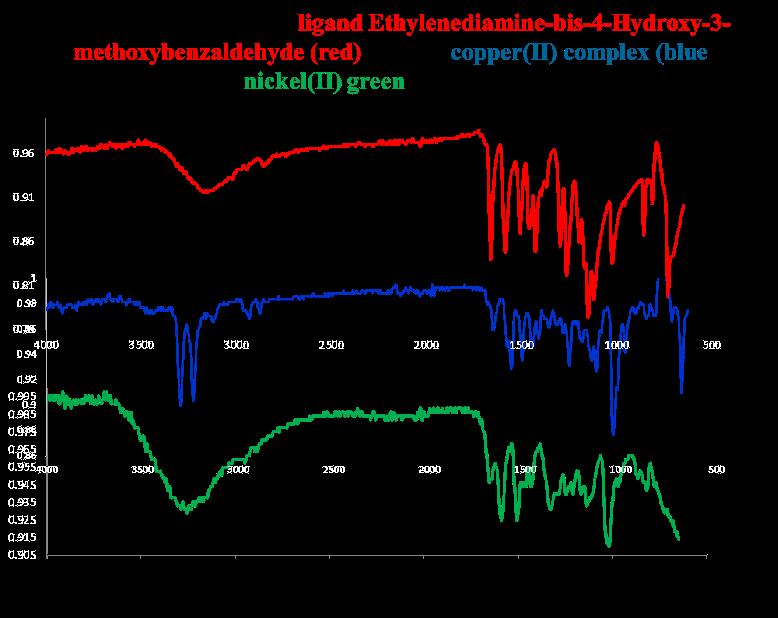
19
Impact/Significance:
The project has achieved the synthesis of the Schiff base ethylene-bis-4hydroxy-3Methoxybenzaldehyde. The transition metal complexes that were formed exhibited different chemical and physical characteristics from the ligand, confirming their synthesis. Project 2 achieved synthesis of 2-hydroxy-3-methoxybenzaldehyde ethylenediamine ligand with transition metal complexes as well. This was confirmed by the differing chemical and physical characteristics shown through FTIR spectroscopy and UV-visibility. The next step in this research is to test the redox and photochemical properties of the synthesized compounds and study their capability as potential catalysts.
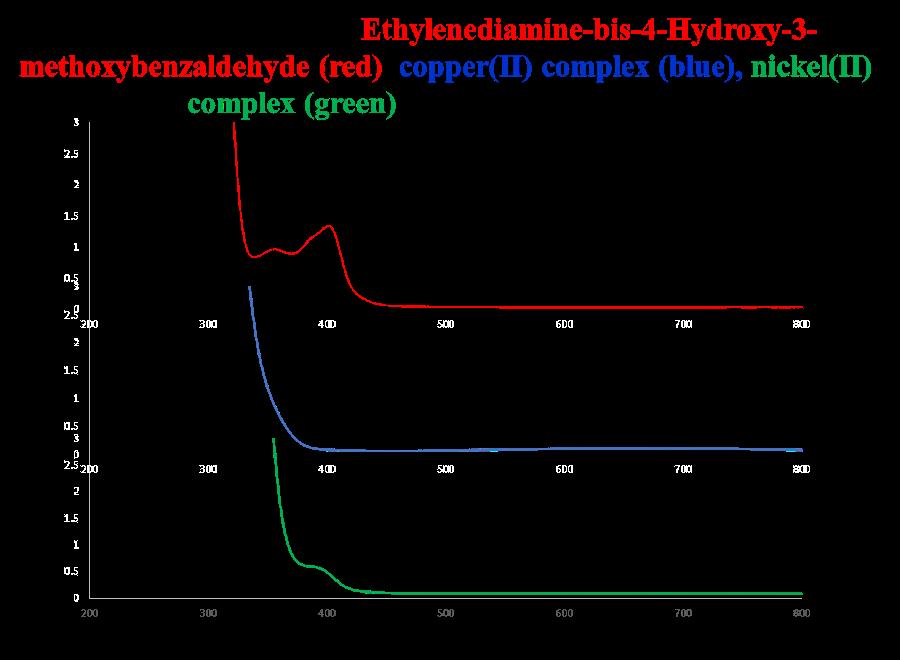
References:
1. Maurya, R.C. Patel, P. and Rajput, S.. Synt. and react. 2003, 817–836,.
2. Subin Kuamr, K. PriyaVarma, C. Reena, V. N. Aravindakshan, K. K. J. Pharm. Sci. & Res. 9, 2017, 1317-1323.
3. Kotova, O.; Eliseeva, S.; Averjushkin, A’; Lepnev, L.; Vaschenko, A. Rus. Chem. Bull., Int. Ed., 2008, 57, 1880 1889.
20
Measurement of Hysteresis Curves in Soft Magnetic Materials
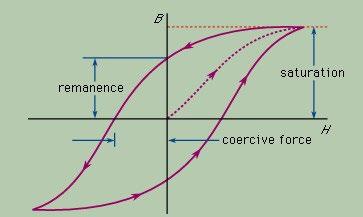 Carlos Ridley and Kevin Storr*
Carlos Ridley and Kevin Storr*
Department of Chemistry and Physics, College of Arts and Sciences
Introduction:
Hysteresis is a unique quality that applies to ferromagnetic material. This is when a remnant magnetic field remains after an external field is applied and removed. The graph of Hysteresis, when plotted on a Magnetic Moment vs. Field measurement, can be further broken down into the three areas of Saturation, Remanence, and Coercivity. Saturation can be described as the point when the sample’s magnetic dipoles stop aligning with the applied field. It will look like the Hysteresis curve will approach an absolute maximum or minimum value depending on the direction of the applied field. Remanence is the offset of the Magnetic Moment once the applied field is zero once again. This is where the graph is visually offset from the initial path and while the Field is decreasing back down to zero, the Magnetic Moment takes a new path as it approaches this asymptote. Coercivity is the offset of the Magnetic Field needed to demagnetize or bring the Magnetic Moments to zero. It can be used to determine the application of the material. Materials with high Coercivity are often used as permanent magnets, while low Coercivity materials are used in transformers, microwaves, and several other electrical devices.
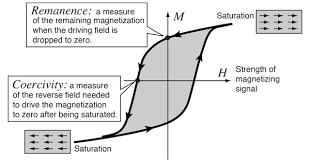
Objectives/goals:
The objective of this project is to measure the magnetic behavior in the material, Cobalt Iron Vanadium, commonly known as Hiperco 50.
Materials and Methods:
In order to measure the magnetic behavior of Hiperco 50, the Vibrating Sample Magnetometry option on the Quantum Design Versalab was used to conduct the experiment. This option measures the Magnetic Field against the Magnetic Moment at a constant temperature. The experiment was conducted at 50K, 75K, 100K, 150K, 200K, 250K, 300K, 350K, 400K, which is the full temperature range for the Versalab system. For each measurement the Magnetic Field was swept from 0T to 3T.
Results and Discussion:
21
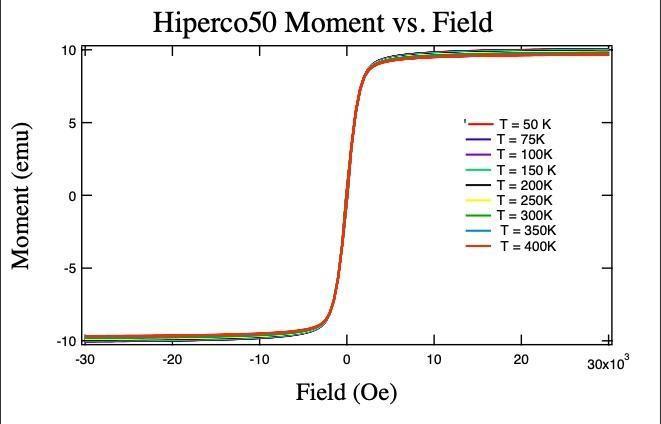
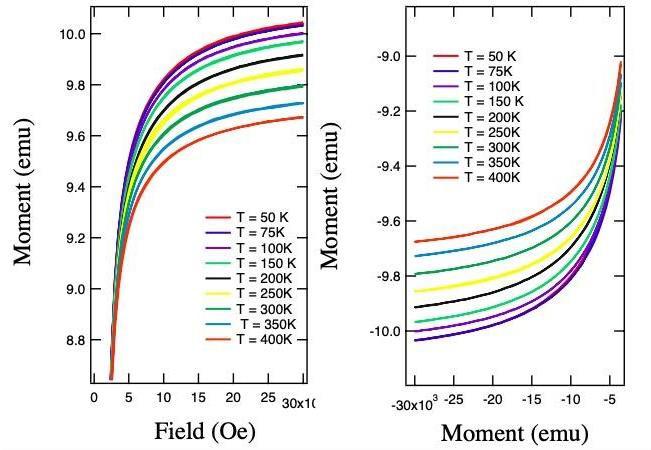
22
Impact/Significance:
The results show that the Hiperco 50 has a low Coercivity, and consistent magnetic behavior. As well as a decrease in the magnitude of the Magnetic Moment as temperature increased. The results also show the material has minimal Hysteresis behavior, due to the low Coercivity and Remanence. This material would be suitable to be used in electrical applications.
References:
1. Chikazumi, Sōshin, et al. Physics of Ferromagnetism. Oxford University Press, 1997.
2. Foner, Simon. “Versatile and Sensitive Vibrating-Sample Magnetometer.” Review of Scientific Instruments, vol. 30, no. 7, 1959, pp. 548–557, https://doi.org/10.1063/1.1716679.
23
Computer Science
Smart irrigation IoT Project
Sai Tejas Janjur and Ahmed Ahmed* Department of Computer Science, College of Computer Science
Introduction:
In an era where technology is rapidly transforming conventional norms and practices, agriculture stands as one of the sectors ripe for revolution. The need for more efficient, scalable, and sustainable methods of farming has never been more apparent than in the face of mounting global food demand and an increasing focus on environmental stewardship. In response to these pressing issues, the Computer Science IoT Lab has decided to harness the power of Internet of Things (IoT) technologies to optimize traditional agricultural practices.
Our key focus was to develop a sophisticated, smart irrigation system capable of dynamically adapting to the individual watering needs of diverse plant species and the fluctuating moisture levels of the soil. By combining agricultural knowledge with advanced technology, we sought to create an innovative solution that could mitigate water wastage, foster optimal plant growth conditions, and eventually serve as a model for sustainable farming practices in the digital age.
Objectives/goals:
The project was guided by a clear and multifaceted set of objectives, each aimed at enhancing the efficacy and efficiency of agricultural irrigation:
Development of an Integrated Control System: To devise an integrated control system that would effectively interface with soil moisture sensors. This would enable real-time data collection and accurate measurement of soil moisture levels, a critical parameter influencing the watering needs of plants.
Creation of an Adaptive Algorithm: The core computational engine of the system would be an adaptive algorithm, designed to intelligently analyze real-time data from the moisture sensors and control water flow accordingly. The algorithm would adjust irrigation patterns based on realtime soil moisture data and specific watering needs of each plant species.
Development of a Customizable User Interface: Recognizing the diversity in agricultural practices and plant species grown, we aimed to develop a user interface that could be easily customized by farmers. This would offer them the flexibility to input specific plant types and adjust watering schedules manually, thereby providing a more personalized and efficient farming experience.
24
Integration of Weather Forecast Data: In an attempt to further enhance the system's efficiency, we aimed to integrate local weather forecast data into our system. Incorporating predictive weather data, such as rainfall, would allow the system to intelligently adjust watering schedules, thus saving water and preventing unnecessary irrigation when rain was anticipated.
Materials and Methods: The project's approach was multi-dimensional, encompassing hardware integration, software development, data analysis, and user interface design. Here's an expanded outline of the methods employed:
Sensor Integration: The backbone of the smart irrigation system is a network of soil moisture sensors. These sensors, embedded in the soil, can detect changes in moisture level. We integrated these sensors into the broader system, ensuring they were connected to our control system for real-time data collection. We faced initial challenges with sensor integration, especially with discrepancies in data due to inconsistent sensor placement within different soil types. We devised a unique mounting solution, standardizing sensor placement across various soil conditions and thus improving the accuracy of moisture data.
Adaptive Algorithm Development: The next crucial step was the creation of an adaptive algorithm, effectively acting as the 'brain' of our irrigation system. This algorithm used data from the moisture sensors to control the water flow dynamically. It was programmed to consider various factors such as the specific watering needs of each plant species, the real-time soil moisture data, and the local weather forecast. This smart, responsive approach resulted in a highly effective and adaptive irrigation system.
User Interface Design: A key aspect of our project was user experience. Acknowledging the need for a farmer-friendly interface, we designed a customizable user interface for our system. This interface allowed farmers to input plant types and adjust watering schedules as per their preference, providing a highly personalized farming experience. It was designed to be intuitive, user-friendly, and accommodating to varying levels of technological expertise.
Integration of Weather Forecast Data: In a bid to optimize water usage further, we integrated local weather forecast data into our system. This predictive information enabled the irrigation system to adapt watering schedules based on rainfall forecasts. For instance, if rain was expected within a day, the system would minimize or stop irrigation, thus conserving water and preventing unnecessary watering.
Field Testing: After the development and integration phases, the smart irrigation system underwent rigorous testing under various conditions. These tests aimed to evaluate the system's response to fluctuating moisture levels, diverse plant water requirements, and changing weather conditions.
25
Each of these methods contributed to developing a highly responsive and user-friendly smart irrigation system capable of revolutionizing traditional agricultural practices. Through an iterative process of development, testing, and refinement, we created a system that truly stands at the intersection of technological innovation and agricultural need.
Results and Discussion:
The project yielded promising results: Sensor Placement: We successfully addressed the issue of inconsistent moisture data due to varying sensor placement within different soil types. A unique sensor mounting solution was developed to standardize sensor placement and ensure accurate data capture across various soil conditions.
Adaptive Algorithm: The algorithm that was developed successfully adjusted irrigation patterns based on real-time soil moisture data and specific watering needs of each plant species. User Interface: The creation of a customizable user interface allows us to input specific plant types and adjust watering schedules manually, if necessary, offering a more personalized and efficient farming experience.
Weather Data Integration: Incorporating predictive data like rainfall into the algorithm enhanced the system's efficiency, allowing it to intelligently adjust watering schedules, thus saving water and preventing unnecessary irrigation.
Impact/Significance:
The potential impact of our project is far-reaching. Through the successful implementation of IoT in agriculture, we have showcased the vast potential of interdisciplinary collaboration and the transformative power of computer science.
The application of an automated irrigation system provides several significant advantages. Foremost, it optimizes water usage, one of the most critical and scarce resources globally. By fine-tuning the irrigation process to respond to real-time soil and weather conditions and the specific needs of different plant species, we can dramatically reduce water wastage. This not only results in economic savings for farmers but also contributes significantly to the broader objective of sustainable water management.
The system also promotes the optimal growth of crops. By ensuring that plants receive the right amount of water at the right time, we enhance their overall health and productivity, potentially leading to increased crop yields and hence, more profitable farming.
In terms of user experience, the system's customizable interface empowers farmers, providing them with more control over their irrigation practices. This fosters efficiency and personalization in a field that has often been constrained by 'one-size-fits-all' solutions. Moreover, the wider implications of this project for the agriculture sector and society at large cannot be overstated. As a testament to the potential of IoT in revolutionizing traditional fields,
26
this project paves the way for further exploration and innovation in this domain. This approach to farming could help us address some of the most pressing challenges of our times - food security, water conservation, and climate change. In the long run, the model of intelligent, sustainable, and efficient farming promoted by our project could indeed shape the future of agriculture.
27
Introduction:
Education
TexSTEM: Producing PV STEM Teachers
Danielle Law Spring, Marilynn Jones, and Beverly King Miller*
Department of Curriculum and Instruction, College of Education
The United States faces a dire STEM teacher shortage (Feder, 2022). There are up to 100,000 high school STEM teachers and 150,000 middle school STEM teachers needed. Further, Feder (2022) reports that to resolve this shortage, the US would need to produce 10,000 STEM educators for one decade straight. Partee (2014) found that teachers of color tend to remain in high-poverty schools and districts and consider it a commitment to see the success of children of color while also being a much-needed role model.
Although the 106 HBCU’s in the United States represent only 3% of all-American Colleges and Universities, they produce almost 20% of all African American graduates and even more important, 25% of African American graduates in STEM (uncf.org,2023).
Those of African descent and Latinx heritage are underrepresented in STEM (science, technology, engineering and mathematics) (King Miller, 2013, 2015, 2017). As a teacher preparation program, the College of Education does not adequately address STEM teaching that would provide the state of Texas with qualified STEM trained teachers to meet the demands for science teachers.
Objectives/goals:
The TexSTEM research project and longitudinal study is in its second year. The three initiatives for the project include: 1) data reporting and analysis of STEM needs for two identified School districts, 2) gathering STEM competition data and assessment of needs for identified School districts and, 3) building networks and partnerships with local and International STEM collaborators to enhance PVAMU and HBCU partnerships. In year two the project shifted to providing experiential learning opportunities for PV students as a result of the building of STEM collaborations.
Materials and Methods:
For this qualitative case study( Creswell, 2007), data came from pre and post surveys collected from participants to STEM experiential events field trips) offered as a result of the TexSTEM data. A flyer was distributed across campus to students from Arts and Science, Agriculture, and the College of Engineering in order to attract STEM students who may also want to qualify as a public-school STEM educator. Two field trip programs were offered this school year. The first one in the fall had 9 students and 6 faculty/administrators who attended the program. There were
28
7 students from the college of education and 2 from the college of engineering. The second field trip had 3 students and 3 faculty who participated.
The data represented here is from the fall field trip to the NASA ION Center and comes from a pre-demographic Qualtrics survey sent to students to find out their reason for signing up for this field experience. The post survey gave more information regarding their experience and feedback. However, it also included questions for the adult faculty and administration who attended. Unfortunately, only 6 of the 9-student responded so data was very sparse.
The second project offered 3 students an opportunity to volunteer and implement an Education Day project at the International Science and Engineering Fair (ISEF) in Dallas, Texas. This data is still being analyzed.
Results and Discussion:
The data represents a small sample of participants who attended the STEM event at the NASA ION Center in Houston, Texas. Of the nine students 71% reported an interest in STEM teaching at grades 4-8. In this group, one graduated in May and will be a math teacher in the local Texas district. 57% indicated interest in teaching at the middle to high school level. With the severe teacher shortage and specifically in STEM teachers, their response is welcome. Field trips tied to college courses is seen as a value to HBCU in Texas, therefore, funds need to be allocated for such initiatives.
Impact/Significance:
This longitudinal study has evolved to include not only building networks, but providing collaborations for PV students through STEM experiential opportunities. This work is under IRB. Data has not been presented at conference, however, a publication is pending for submission August 2023 to meet the November deadline in the Journal of Experiential Learning. This journal will best support our manuscript focus on the importance of experiential STEM learning opportunities for students.
References:
1. Creswell, J. W. (2007). Qualitative inquiry and research design: Choosing among five approaches (2nd ed.). Sage Publications, Inc.
2. UNCF. (2023, June, 14) The Numbers Don’t Lie: HBCUs Are Changing the College
Landscape. uncf.org. https://uncf.org/the-latest/the-numbers-dont-lie-hbcus-are-changingthe-college landscape#:~:text=Some%20of%20the%20most%20heartening,of%20all%20African%2 0American%20graduates.
3. NCES. (2022, Dec. 6) Forty-Five Percent of Public Schools Operating Without a Full Teaching Staff in October, New NCES Data Show. Nces.ed.gov.
https://nces.ed.gov/whatsnew/press_releases/12_6_2022.asp?utm_content=&utm_mediu m=email&utm_name=&utm_source=govdelivery&utm_term=
29
4. King Miller, B. (May 2022). “Collaboration for Candidate Success on TEXES Exams in Science. Presentation to PV Arts and Sciences Dept. on Teacher Candidate Science Scores on EC-6 Tests.

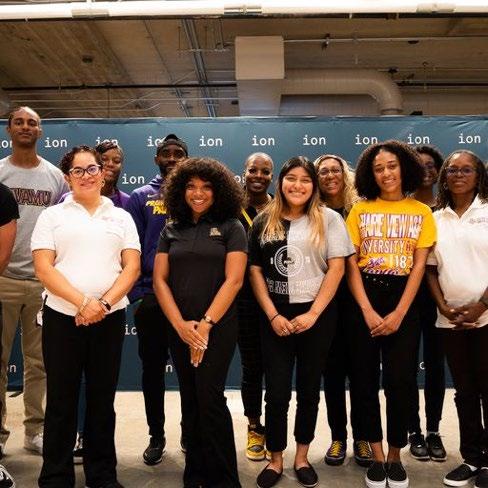
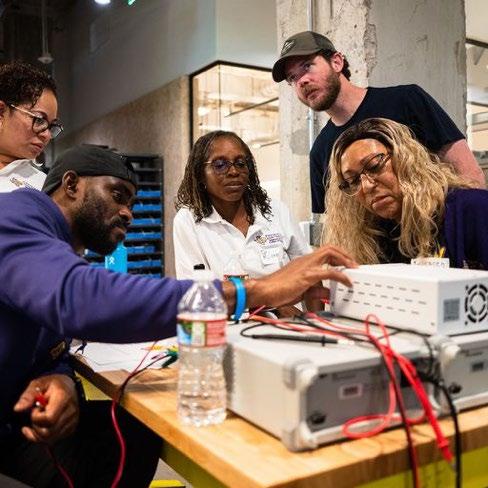
5. King Miller, B. (2017). Navigating STEM: Afro Caribbean Women Overcoming Barriers of Gender and Race. Sage Open. October – December 1-14. Doi: 10.1177/2158244017742689.
6. King Miller, B. (2015). Effective Teachers: Culturally Relevant Teaching from the Voices of Afro Caribbean Immigrant Females in STEM. Sage Open. July-September 2015, 1-14. Doi: 10.1177/2158244015603427.
7. King Miller, B. (2013). "The Experiences of Panamanian Afro-Caribbean Women in STEM: Voices to Inform Work with Black Females in STEM Education.”.
https://digitalrepository.unm.edu/educ_llss_etds/54
8. Partee, G, ( 2014). Retaining Teachers of Color in our Public Schools. Center for American Progress 2050. https://files.eric.ed.gov/fulltext/ED561078.pdf
NASA ION Pictures- September 23, 2022
30
Evaluating the Influence of Identity on Perceptions of Mental Health, Exercise, and Sport Among
Collegiate Students
Saabiraa Robinson and Jasmine Hamilton*
Department of Health and Kinesiology, Whitlowe R. Green College of Education
Introduction:
While society continues to navigate and uncover the influences of the COVID-19 pandemic, mental health concerns such as anxiety have been illuminated. Self-perception is rooted in identity and may serve as a mediating factor for mental and physical health and access to resources within young adults. Thus, in a population where anxiety may be associated with academic performance, college students are also having to deal with stressors from other aspects of life. Sport and physical activity have been identified as mechanisms for coping with stress and anxiety. College students have access to campus resources such as recreational centers, intramural sports, and athletic facilities; all of which can be used to help with anxiety and depression.
Objectives/goals:
This project sought to explore the mediating factors between identity and social determinants such as race/ethnicity, age, sex/gender, and access to campus resources for college students. Furthermore, with Black women having lower representation, identity through gender orientation was also used to evaluate the extant literature.
Materials and Methods:
A literature review was conducted on current mental health statistics, physical activity behaviors, and resource access for collegiate students. Keyword searches included: college mental health, anxiety in college students, anxiety and student athletes, use of campus resources, and mental health rates/prevalence in Black/African American students. Academic Search Complete, an online database was used to explore scholarly peer-reviewed articles through keywords derived from the intended variables. Additionally, databases were found with information on mental health prevalence, college resource access and utilization, and relevant statistics for Black/African American college students. Lastly, a comparative analysis was initiated to determine gaps in research, trends in data, and emerging themes.
Results and Discussion:
Approximately 62.9% of college students experienced overwhelming anxiety while sexual and racial minority college students who reported unmet social determinants of health needs were more at risk for experiencing symptoms of anxiety (Johnson, 2022). During the COVID-19 pandemic, Black Americans had better mental health than their Non-Black American counterparts (Owens & Saw, 2021). Training in sports increased college students’ mental toughness and reduced negative feelings (Cui & Zhang, 2022). Also, physical exercise and fitness can manage anxiety in college students (Zhu & Cheng, 2022). Physical activity participation may help to manage anxiety in college students. However, the previous studies did
31
not include large samples of Black or African American college students. Thus, this study provides a unique contribution.

Impact/Significance:
Saabiraa was able to share findings at the symposium and later at a national conference. This research has highlighted issues affecting students at HBCUs and added to the literature regarding mental and physical health. Thus, Ms. Robinson will be able to continue to contribute to the larger study and publish an article.
References:
Chart 1: Data from 2022 College Student Mental Health Report
32
1. College Student Mental Health Report: Best Colleges. BestColleges.com. (2022, November 21).Retrieved April 5, 2023, from https://www.bestcolleges.com/research/college-student-mental-health/
2. Cui, G. & Zhang, L. (2022). The influence of physical exercise on College Students' negative emotions: the mediating and regulating role of psychological resilience. Journal of Sport Psychology, 31(2), 21-28.
3. Johnson, K.F. (2022). Symptoms of anxiety in College Students and the influence of social determinants of health. Journal of College Student Psychotherapy, 36(4), 339-354.
https://doi.org/10.1080/87568225.2020.1827114
4. Owens, V. & Saw, H-W. (2021). Black Americans demonstrate comparatively low levels of depression and anxiety during the COVID-19 pandemic. PLoSONE, 16(6). https://doi.org/10.1371/journal.pone.0253654
5. Zhu, X. & Cheng, H. (2022). The effect of physical fitness exercise on relieving psychological anxiety of College Students. Journal of Sport Psychology, 31(2), 42-51.
33
Assessing the Inclusion of
Universal Design for Learning (UDL) in Higher Education Institutions Curriculum
Skylar Fort, Jaelyn Howe and Andrea McDonald* Department of Health and Kinesiology, College of Education
Introduction:
Universal Design for Learning (UDL) is a set of principles for designing a curriculum that provides all individuals with equal opportunities to learn. UDL guides the design of learning experiences to proactively meet the needs of all learners regardless of ability, disability, age, gender, or cultural and linguistic background. UDL provides a blueprint for designing goals, methods, materials, and assessments to reach all students, including those with diverse needs. Although these set principles are proven to be effective, several studies have documented that many higher education institutions have not fully implemented these principles in their curricula.
Objectives/goals:
This proposed study was to examine how the Universal Design for Learning principles integrates into the health curriculum, classroom instructions, and delivery to facilitate learning. The study aims to answer two objectives (1) conduct an evaluation of faculty in higher education knowledge and application of UDL principles in their classroom and (2) develop and test a UDL handbook to help guide faculty with the UDL process and continuous improvement.
Materials and Methods:
We proposed to collect qualitative and quantitative information about the UDL principles and develop a training manual for faculty in higher education. However, I had difficulty identifying students to work during Fall 2023. However, in the Spring of 2023, I identified two students. Since then, we have created the manual and applied for IRB approval. In July 2023, the proposal was approved, and now we can start collecting
References:
1. Courey, S. J., Tappe, P., Siker, J., & LePage, P. (2013). Improved lesson planning with universal design for learning (UDL). Teacher education and special education, 36(1), 727.
2. United States Laws." WebAIM: Web Accessibility in Mind, Retrieved on July 31, 2022, from webaim.org/articles/laws/usa/.
34
The Promotion
of Women at Historically Black Colleges and Universities as it Relates to the Imposter Phenomenon
Al Leah Freeman, Patricia Hoffman-Miller, Ph.D.* Department of Educational Leadership & Counseling, College of Education
Introduction:
Writers have written about the invisibility of women in positions of power, citing barriers that women leaders face relative to their contexts (Phakeng, 2015; Hesanmi ,2018; Poltera, 2019). In fact, as diversity in the workplace increases, the complexities surrounding the challenges faced by women continues to evolve. There has been a shift in women entering the workforce in record numbers allowing them the opportunity to have successful careers and expand their professional influences, particularly in respect to leadership positions (Schock, Gruber, Scherndl, & Ortner, 2018). More precisely, a little over half (50.8%) of the United States population is female (National Center for Statistics, 2019). In addition, they earn more than 57 percent of undergraduate degrees and 59 percent of all master’s degrees; and they provide 47 percent of the United States’ labor force and 52. 5 percent of college educated workforce (Warner, Ellmann, & Boesch, 2018). Yet, women are severely underrepresented in the upper levels of leadership, especially in the academy. In trying to understand this invisibility, African societies frequently use Eurocentric feminist theories instead of African epistemologies this study focused on perceptions of African American women at an HBCU.
Deeply embedded in American culture is the belief that hard work plus education will lead to social and economic success and parity, regardless of gender, race, or class. While education and hard work are salient to a successful life, they are not the only determinant of goal accomplishments for African American women in the academy. Accepting this premise, the researchers sought to identify the learned experiences of African American women in higher education to see if the Imposter Phenomena impacted their promotion and tenure process at a Historically Black College and University (HBCUE) in southwest Texas.
Objectives/goals:
The imposter phenomenon was originally identified by Clance and Imes (1978) to describe the feelings of fraudulence reported by high achieving women. Imposters doubt their achievements are a result of their ability and instead attribute their success to non-ability factors. Whether imposters are men or women, Clance and O’Toole (1988) stated that “women are more likely to be limited, than men according to their research and the Imposter Phenomenon. They assumed that men find support from mentors and society in general, which prevents imposter fears from having detrimental effects on their lives. Women, on the other hand, do not have such strong support networks that would help them accomplish their goals, which inspired this research and prompted the following two objectives of this study.
1. Is the prevalence of Imposter Phenomenon is found in the sample of women in academia at a HBCU consistent with that reported in literature?
2. Does Imposter Phenomenon levels differ across discipline areas at an HBCU?
Materials and Methods:
35
Due to unforeseen circumstances, the P.I. was not able to develop the focus group at the time this report was written. However, a focus group will be selected utilizing a strict protocol of stratified sampling. Once selected participants will be emailed the survey (Clance Imposter Phenomenon Survey -CIPS). Permission to use the CIPS has been granted by Dr. Clance in 2021. Utilizing quantitative data and subsequent analysis will allow my faculty advisor to have a deeper understanding of how IP affects women at a HBCU.
Results and Discussion:
The project evaluation plan consists of using both formative and summative evaluation methods to document progress towards achieving the goas, objectives, and outcomes. However, at the time of submission the results were unavailable. At the time of my Abstract submission, my research professor was identifying females who have received tenure and/or leadership positions at an HBCU in southeast Texas. After the participants are selected, a formal inquiry as to their availability to participate in the study will be emailed along with the link for the survey (Clance Impostor Phenomenon Survey -CIPS ). The study is ongoing. However, I was able to gather relative literature to the study, analyze the literature, and provide synopsis of the literature to be used by my advisor for future studies and the completion of this research.
Impact/Significance:
This was the first time that I had the opportunity to participate in conducting empirical research. I was also able to attend national and international conferences to better understand the importance of research and how to present research. The impact of this study will impact motivation and can be a great thing for job mastery. I found, interestingly, that understanding the imposter phenomenon actually improves interpersonal performance at work: helping people, cooperating, and encouraging others. This research project not only increased my skill in identifying a research problem, but all the components in solving the problem, as well ask helping me to better understand my thinking to improve my professional career. The Impostor Phenomenon has been studied for decades, but has not been examined in HBCUs specifically with African American women, neither has research examined how it can lead to future success. This study when completed, with create a new body of knowledge for African American women and the Impostor Phenomenon.
References:
1. Chance, P. R. and Imes, S A. (1978). The imposter phenomenon in high achieving women: Dynamics and therapeutic interventions. Psychotherapy: Theory, Research, and Practice, 15(3), 241–247.
https://doi.org/10.1037/h0086006
2. Clance, P.R. & O’Toole, M.A. (1988). The imposter phenomenon: An internal barrier to empowerment and achievement. Haworth Press, Inc.
3. Ilesanmi O.O (2018). “Women‟s Visibility in Decision-making Processes in Africa: Progress, Challenges, and Way Forward,” Frontiers in Sociology.
https://doi.org/10.3389/fsoc.2018.00038
4. National Center for Education Statistics. (2019). Status and Trends in the Education of Racial and Ethnic Groups 2018. D.C.: U.S. Department of Education
36
5. Phakeng M (2015). “Leadership: The Invisibility of African Women and the Masculinity of Power,” South African Journal of Science. http:// dx.doi.org/10.17159/sajs.2015/ a0126
6. Poltera J. (2019). “Exploring Examples of Women‟s Leadership in African Contexts,” Agenda, https:// 10.1080/10130950.2019.1602977
7. Warner, J. Ellmann, N, & Boesch, D. (November 2018). “The Women’s Leadership Gap.” The Center for American Progress, https://www.americanprogress.org/article/womens-leadership-gap-2/
8. Schock A.-K., Gruber F. M., Scherndl T., Ortner T. M. (2018). Tempering agency with communion increases women’s leadership emergence in all-women groups: evidence for role congruity theory in a field setting. Leadership. Q. 10.1016/j.leaqua.2018.08.003
37
Engineering
Lipase-Catalyzed Hydrolysis of Triglycerides from Yellow Nutsedge Tubers and Seeds of Switchgrass
Dynasty Stephenson and Michael Gyamerah*
Department of Chemical Engineering, College of Engineering
Introduction:
The need to avoid food shortages and the search for reliable and renewable non-edible oil feedstocks as triglyceride sources for biodiesel and specialty chemicals production have led to increased research in substitutes for food-crop derived triglycerides. The profile of triglycerides in the seeds of switchgrass showed that switchgrass seeds contain 100 % of known triglycerides of found in edible vegetables oils such as sunflower, corn and soy bean oils. In addition, 89.6% of the triglyceride of switch grass consisted of oleic and linoleic acids which are the principal components for specialty chemicals and high-performance fuel additives. Free fatty acids from triglycerides have been produced traditionally using the Colgate-Emery process which requires very high temperatures and pressures of about 250 ℃ and 50 atm [1] These process conditions result in undesirable side reactions and high energy cost in addition to high cost corrosionresistant process equipment. Interest in developing enzyme (lipase) catalyzed hydrolysis of triglycerides to free fatty acids has been studied extensively to take advantage of the environmentally benign process conditions requiring temperatures of 30 – 35 ℃ and low energy requirements and very high selectivity and yields that lead to high purity free fatty acids. The lipase-catalyzed hydrolysis reactions take place in three reversible steps:
C3H5(OOCR)3 + H2O
C3H5(OH)(OOCR)2 + R-COOH Triglyceride water diglyceride fatty acid
C3H5(OH)(OOCR)2 + H2O
C3H5(OH)2(OOCR) + R-COOH diglyceride water monoglyceride fatty acid
C3H5(OH)2(OOCR) + H2O
C3H5(OH)3 + R-COOH
Monoglyceride water glycerol fatty acid
Here, we report initial results of a new green chemistry procedure for the hydrolysis of triglycerides from switchgrass seeds yellow nutsedge tubers using lipase from Candida rugosa. The objective of this study was to evaluate the hydrolysis of triglycerides from different energy crops using C. rugosa lipase and identify their suitability for production of specialty chemicals and high-performance fuel additives. The hydrolysis of triglycerides from yellow nutsedge tubers (Cyperus esculentus) and seeds of switchgrass (Panicum virgatum L) using the lipase from C.
38
rugosa were studied in 100-mL Erlenmeyer flasks with a reaction mixture consisting of 50mM phosphate buffer pH 7.0 and the appropriate triglyceride and incubated at 25 ℃ and 100 rpm.
Materials and Methods:
Lipase from Candida rugosa, was obtained from Sigma-Aldrich (St. Louis, MO.) and used as received for the research. Acetone in ethanol were obtained from Fisher Scientific (Fair Lawn, NJ.). The triglycerides used were extracted from yellow nutsedge tubers, and seeds of switchgrass as reported by Agyeman et. al. [2].
The modified method was as follows. The reaction mixture in a 100-mL Erlenmeyer flask had a total volume of 20-mL and consisted of the lipase in 50 mM phosphate buffer of pH 7.0 and the appropriate triglyceride. For the Pseudomonas cepacia lipase with 46.02U/mg specific activity, 11.6 mg were added to 100-mL of 50 mM phosphate buffer pH 7.0 to give the stock enzyme preparation for use in lipase catalyzed hydrolysis. The reaction mixture of 20-mL consisted of 8.35 g triglyceride and 6 g of 50 mM buffer solution with a lipase concentration of 460.2 U/mL on a weight basis, the lipase concentration was 0.0055 % w/w of the triglyceride and added enzyme, and the ratio of triglyceride to water (50 mM buffer) was 3:1.
The 100-mL Erlenmeyer flasks containing the reaction mixture were incubated in an incubator shaker at 25 ℃ and 100 rpm. The progress of hydrolysis of the triglycerides extracted from yellow nutsedge tubers and seeds of switch grass by the lipase was based on the method reported by Rooney and Weatherley [1]. At specified time intervals, approximately 1 g samples were removed from the reaction mixture using a 1-mL syringe and transferred into a previously weighed 100-mL flask containing 50-mL of 50% v/v acetone in ethanol. This effectively stopped the lipase catal yzed hydrolysis by denaturing the enzyme and dissolving the oil.
Phenolphthalein indicator was added to the quenched reaction mixture and titrated against either standardized 0.05 M or 0.1 M NaOH solution.
Results and Discussion:
The data in Figures 1 and 2 show that the rate of hydrolysis of the triglycerides was faster for switchgrass compared to yellow nutsedge. Between 5 – 10 minutes the rate of hydrolysis of triglycerides of switchgrass was 0.29% per minute while the rate of hydrolysis of triglycerides of yellow nutsedge 0.20% per minute. This makes the initial rate of hydrolysis triglycerides of switchgrass was 48% faster than hydrolysis of triglycerides of yellow nutsedge. The highest rate of hydrolysis was obtained between 5 – 30 minutes for both switchgrass and yellow nutsedge at 1.44% per minute and 0.94% per minute respectively. At the end of 4 hours the % hydrolysis of the triglycerides of switchgrass to free fatty acids was 52% while 42% hydrolysis was obtained for triglycerides of from yellow nutsedge tuber. The free fatty acid composition of triglycerides from switchgrass seeds and yellow nutsedge tubers [2] showing palmitic, oleic, and linolenic acids respectively 5.3, 23.2, and 70.2 % for switchgrass seeds and 13.9, 73.6, and 8.8% respectively for yellow nutsedge tubers may account for differences in hydrolysis. The % hydrolysis of obtained in this study 42% (yellow nutsedge tubers) and 52% (switchgrass seeds) were lower compared to about 60% hydrolysis of sunflower oil under the same conditions [1]. The lower lipase concentration used in this study compared to that of Rooney and Weatherly [1]
39
and the possible inhibitory compounds in the extracted triglycerides may account for the lower yields.
















0. 15. 30. 45. 60. 0 75 150 225 300 Time (min) 15. 30. 45. 60. 75. 40
Figure 1:
Time course of % hydrolysis of Switchgrass seeds triglycerides with Candida rugosa lipase
Figure 2: Time course of % hydrolysis of Yellow nutsedge tubers triglycerides with Candida rugosa lipase
Conclusion:
The following conclusions may be drawn from the above study.
1. Triglycerides from switchgrass seeds and yellow nutsedge tubers may be hydrolyzed up to 50% in 4 hours under the conditions used in this study.
2. Triglycerides from switchgrass seeds are hydrolyzed 48% faster than triglycerides from yellow nutsedge under the conditions used.
3. The lipase concentration and possible inhibitory compounds in the extracted triglycerides from the yellow nutsedge tubers may account for the lower yields
References:
1. Rooney D and Weatherly LR, (2001) The effect of reaction conditions upon lipase catalyzed hydrolysis of high oleate sunflower oil in a stirred liquid- liquid reactor. Process Biohem 36: 947953
2. Armah-Agyeman G, Gyamerah M, Biney P O, and Woldesenbet S, (2016) Extraction and characterization of triglycerides from coffeeweed and switchgrass seeds as potential feedstocks for biodiesel production. J Sci Food Agric 96: 4390-4397.
41
Network
Traffic based Ransomware Detection at an Early Stage
Michael Cardoso and Na Li* Department of Computer Science, College of Engineering
Introduction:
WannaCry, also known as Wannacrypt0r, is a ransomware virus that exploits a vulnerability called Eternal Blue developed by the NSA to take advantage of Windows SMB protocol. Eternal Blue was leaked by a hacker group called the shadow brokers and then implemented into WannaCry. The ransomware uses this exploit to encrypt and propagate to other computers on the network. The first attacks started around May 2017, with the attackers wanting three hundred dollars, later the amount was increased to six hundred dollars’ worth in Bitcoin. In 2017, this ransomware attacked around two hundred and thirty thousand computers worldwide. The Spanish telecommunications company Telefonica. This was one of the first victims of this malware in terms of a large-scale impact. furthermore, the most well-known and disastrous was the breach of the NHS, the universal health care in the United Kingdom. This caused a third of the trust to be impacted and nineteen thousand appointments had to be canceled. Costing the healthcare ninety-two million pounds as a result. Furthermore, WannaCry has not only infected Europe but 150 countries and cost four billion dollars around the world. For these reasons, it is to the world’s benefit to be able to detect when a ransomware attack is happening before the encryption takes place.
Materials and Methods:
• Windows 10 or 11 with 6 cores and 16 Gb ram
• Virtual box installed.
• VM with Ubuntu 20.4
• Wireshark installed.
• Cuckoo sandbox installed.
The methodology for this research involved several key steps. Firstly, a total of 30 Python scripts were created to mimic human behavior. Furthermore, out of the 30, 15 of these scripts execute the WannaCry virus with human mimicry. These scripts were utilized by Cuckoo.
The Cuckoo Sandbox, a popular automated malware analysis platform/sandbox, was implemented to collect the data and perform dynamic analysis of any executable. The PCAPs provided valuable insights into the network traffic by the virus during execution.
The next step of the methodology involved converting the raw PCAP files into flow-based CSV files using NetFlow techniques. This conversion allowed us to extract and organize the network flow information.
To address collision issues that can arise in NetFlow data, various collision handling techniques were used. A collision happens when a flow of the same flow key is labeled both infected and benign. These techniques included majority vote, drop all, drop minority, favor infected, and favor benign.
42
The majority vote changes the flow of the minority vote to the majority. Furthermore, drop all will drop all flows that contain a collision, drop minority will only drop the flows in the minority vote. Also, it will favor infected or benign and will change all collisions to either infected or benign.
Four machine learning algorithms were used Extra Trees, Random Forest, SVM, and Gradient Boosting.
Tenfold cross-validation was used to analyze the accuracy of each algorithm. This approach involved partitioning the preprocessed PCAP data into ten subsets and training the algorithms on nine subsets. Then evaluate their performance on the remaining subset. This process was repeated ten times, with each subset serving as the evaluation set once.
Results and Discussion:
The results, using tenfold, showed that using the preprocessing techniques Favor Infected and Favor Benign yielded an accuracy of 95% with any machine learning algorithm used.
The analysis demonstrated that machine learning algorithms can successfully identify the WannaCry virus. The collision handling techniques helped increase the accuracy of our ML algorithms on the analysis results.
Conclusion:
In conclusion, this report’s goal was to show the reader that one can use several machine learning algorithms to detect a breach in a computer. Therefore, preventing a compromise in the network of a large organization. The findings as stated in this report can demonstrate that by using processed data from PCAPs and ML algorithms one is able to detect malicious activity quite successfully.
References:
1. National Cybersecurity and Communications Integration Center, WHAT IS WANNACRY/WANACRYPT0R
https://www.cisa.gov/sites/default/files/FactSheets/NCCIC%20ICS_FactSheet_WannaCr y_Ransomware_ S508C.pdf (2023)
2. Kaspersky, What is WannaCry ransomware
https://usa.kaspersky.com/resourcecenter/threats/ransomware-wannacry (2023)
3. Q. Chen and R. A. Bridges, "Automated Behavioral Analysis of Malware: A Case Study of WannaCry Ransomware," 2017 16th IEEE International Conference on Machine Learning and Applications (ICMLA), Cancun, Mexico, 2017, pp. 454-460, doi:10.1109/ICMLA.2017.0-119. URL:
https://ieeexplore.ieee.org/stamp/stamp.jsp?tp=&arnumber=8260673&isnumber=826059
7 43
4. Antoine Delplace, Sheryl Hermoso, Kristofer Anandita “Cyber Attack Detection thanks to Machine Learning Algorithms” May 17, 2019 pp.4-6
5. Chen, Q., Islam, S.R., Haswell, H., Bridges, R.A. (2019). Automated Ransomware Behavior Analysis: Pattern Extraction and Early Detection. In: Liu, F., Xu, J., Xu, S., Yung, M. (eds) Science of Cyber Security. SciSec 2019. Lecture Notes in Computer Science(), vol 11933. Springer, Cham. https://doi.org/10.1007/978-3-03034637-9_15
44
Engaging
Undergraduate Researchers in Developing Automatic Data Analysis Tools
Muhammed Zaidi and Yuhao Xu*
Department of Mechanical Engineering, College of Engineering
Introduction:
With the motivation to improve fuel efficiency, the aerospace industry strives to gain a better understanding of the combustion process of jet fuel and its components. For this purpose, freefloating droplet combustion experiments were conducted in the Combustion Integrated Rack (CIR) onboard the International Space Station (ISS) as part of NASA’s Flame Extinguishment Experiment (FLEX) and the subsequent FLEX-2 programs [1-3]. During the FLEX-2 experiments, a free-floating fuel droplet was ignited using energized Kanthal coils. The droplet burning history was recorded by a back-lit black and white (BW) camera, and the recorded images can be used to measure the droplet (D) and soot shell (Ds) diameters to obtain combustion properties such as the droplet burning rate (K) and soot stand-off ratio (SSR). In the past, various ways of extracting the droplet diameters from images were developed by researchers, and these methods can be summarized as either a rule-based computer algorithm or manual measurements performed by researchers [1, 4-6]. However, none of these efforts focused on quantitatively extracting the soot volume fraction (SVF) from the experimental data, which reveals essential information on sooting dynamics and thus provides insights into potential solutions to reduce soot emissions during combustion.
Objectives/goals:
The objectives of this project include the following.
1. Educate the undergraduate student on relevant combustion knowledge to develop an understanding of the data obtained from previous combustion experiments.
2. Propose an automatic program to extract droplet diameter and sooting data from these experimental images.
3. Involve the undergraduate student in designing a droplet generator, a critical component to generate fuel droplets for subsequent combustion experiments and thus obtain quantitative measurements.
Materials and Methods:
This study concerns the Full Field Light Extinction Method (FFLEM) technique to quantify soot emissions. FFLEM is based on the attenuation of light when a laser beam passes through the soot-containing region [7].
The so-called line-of-sight projection data, P(r), is a mathematical parameter that can be expressed as the integration of the field distribution of SVF, fv(R) [7, 8],
where R, r, y, λ, Ke, I, and Io are the direction of interest in the 3-D space, the projection of R onto the plane of the camera sensor, the direction along the light beam, wavelength of light, the
(1)
45
extinction constant, the transmitted, and incident intensity, respectively. The projection data is then inverted topographically using a 3-point Abel deconvolution algorithm to obtain SVF as
where ri = iΔr is the radial distance from the droplet center, Δr is data spacing, and Dik is the operator coefficient for the three-point Abel inversion [8]. This project will use a program to extract the light intensity profile (Eq. 1) and then perform the calculations in Eq. 2 to obtain SVF.
Results and Discussion:
Some efforts were made to understand the expected quantitative results. Some results from the literature review reflect the results we generate within this project. Results show that as you move away from the droplet, SVF increases and then decreases, as shown in Figures 1 and 2.
.
Figure 1: Time sequence of a 1.75 mm n-heptane droplet burning in atmospheric pressure air from .2 to .5 seconds [1].
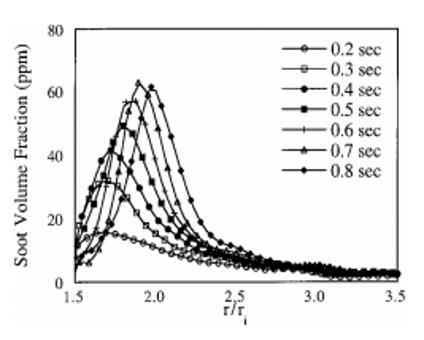
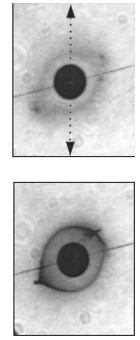
Figure 2: Corresponding results for Figure 1. Here, SVF is plotted against a nondimensional radius. For all times, soot production was constant and increased as the diameter increased [1].
To collect experimental images like those in Figure 1, a fuel droplet must be created and combusted. As such, the student spends time designing a fuel droplet generator. Figure 3 shows the preliminary design, in which a piezoelectric transducer is used to push the liquid fuel through a nozzle to generate fuel droplets.
Impact/Significance:
This project allows the student to gain hands-on experience using computer programs to extract quantitative measurements of combustion experiments. This work also exposes students to engineering design and helps them gain relevant engineering experience

(2)
Figure 3: Preliminary design of a droplet generator.
46
References:
1. Y.C. Liu, Y. Xu, M.C. Hicks, C.T. Avedisian, Comprehensive study of initial diameter effects and other observations on convection-free droplet combustion in the standard atmosphere for n-heptane, n-octane, and n-decane, Combust. Flame, 171 (2016) 27-41.
2. Y. Xu, M.C. Hicks, C.T. Avedisian, The combustion of iso-octane droplets with initial diameters from 0.5 to 5 mm: Effects on burning rate and flame extinction, Proc. Combust. Inst., 36 (2017) 2541-2548.
3. D.L. Dietrich, V. Nayagam, M.C. Hicks, P.V. Ferkul, F.L. Dryer, T. Farouk, B.D. Shaw, H.K. Suh, et al., Droplet Combustion Experiments Aboard the International Space Station, Microgravity Sci. Technol., 26 (2014) 65-76.
4. C.L. Dembia, Y.C. Liu, C.T. Avedisian, Automated data analysis for consecutive images from droplet combustion experiments, Image Anal. Stereology, 31 (2012) 137-148.
5. Y. Xu, C.T. Avedisian, Combustion of n-butanol, gasoline, and n-butanol/gasoline mixture droplets, Energy Fuels, 29 (2015) 3467-3475.
6. Y. Xu, I. Keresztes, A.M. Condo Jr, D. Phillips, P. Pepiot, C.T. Avedisian, Droplet combustion characteristics of algae-derived renewable diesel, conventional #2 diesel, and their mixtures, Fuel, 167 (2016) 295-305.
7. K.-O. Lee, S.L. Manzello, M.Y. Choi, The Effects of Initial Diameter on Sooting and Burning Behavior of Isolated Droplets under Microgravity Conditions, Combust. Sci. Technol., 132 (1998) 139-156.
8. C.J. Dasch, One-dimensional tomography: a comparison of Abel, onion-peeling, and filtered backprojection methods, Appl. Opt., 31 (1992) 1146-1152.
47
Using Nanomaterials for X-ray Radiation Sensing Devices
Jose Angel Nguema Azeme Mangue and M.X. Pulikkathara*
Department of Electrical and Computer Engineering
Introduction:
Precise detection and measurement of ionizing radiation are major challenges faced by the biological, aerospace, and defense industries. Many currently reported instruments for measuring and monitoring exposure to doses of radiation still need to be able to address instrumentation barriers such as size and weight. Nanomaterials, such as lightweight carbon nanotubes having desired electrical properties, were used in this project in polymethyl methacrylate (PMMA) on interdigitated electrodes (IDE) as an X-ray sensor. Due to the aggregation challenges of unfunctionalized nanotubes, a secondary polymer poly(phenylene ethynylene) (PPE) was investigated as a dispersing agent for enhanced separation and consistent electrical measurements. The objectives of this project were: 1) to acquire skill sets with microscopy imaging; 2) obtain electrical measurements while and 3) obtain knowledge of radiation.
Materials and Methods:
Learn how to image these devices and the nanomaterials with scanning electron microscopy and measure electrical properties using a parametric analyzer. Obtain online radiation training.
IDE chips, parametric analyzer and scanning electron microscope [in Dr. Richard Wilkins lab]
Results and Discussion:
SEM imaging of the IDE, and preliminary electrical measurements are presented in RISE poster competition. Received online training certificate for completing radiation training.
Conclusion:
This project needs to continue; skill sets of SEM imaging and parametric measurements have been obtained, and findings are forthcoming.
Jose had won second rank in the RISE poster competition during his RISE. Please see pictures below of his poster and SEM image of an IDE chip. Jose is currently attending an internship at PVAMU for data science.
48
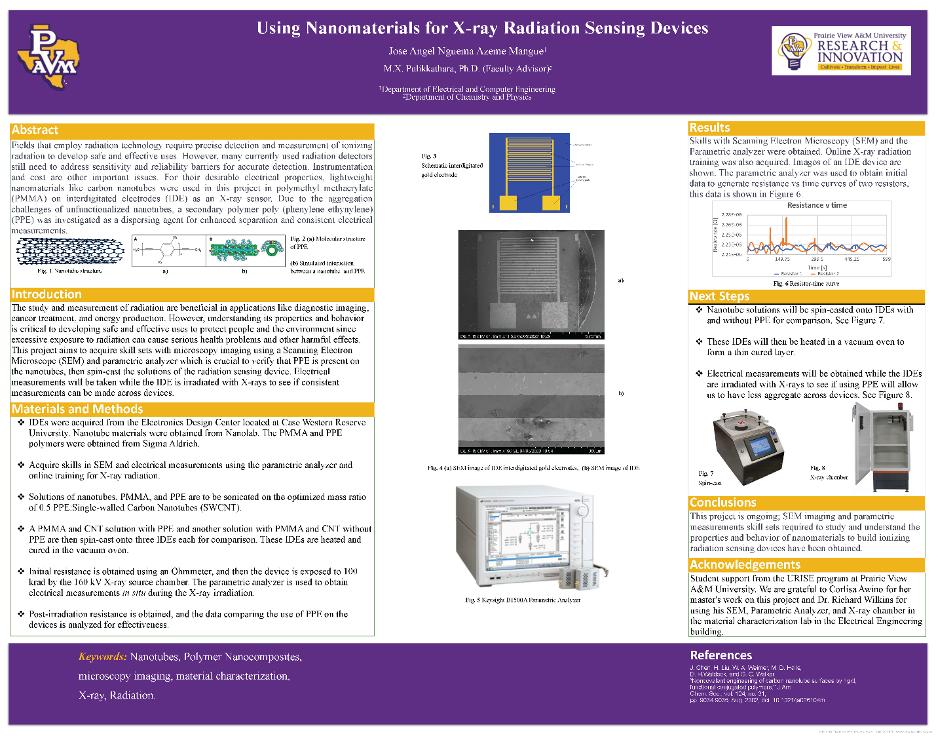
49
Towards
a Robot that can Play Slide Puzzle Games
Caleb Combs and Chang Duan* Department of Mechanical Engineering, College of Engineering
Introduction:
’Robot’ is a term introduced by Czech writer Karel Čapek. Its increasing usage thanks to the booming automotive industry of the 1950’s & 60’s meant it got an official definition: a machine resembling a human being and able to replicate certain human movements and functions automatically [1]. Its continuously increasing appearances in literature spawned more words on the subject.
Robotics, a later word coined by Isaac Asimov [2], has since expanded into an interdisciplinary field with applications in manufacturing, medical, military, space exploration, entertainment, domestic, and household. Currently, there are robots that perform many tasks that might be considered unfit for a human. In manufacturing, these tasks can include cutting, milling, and welding. However, for the most part, these tasks are often simple repetitive motions.
On the other hand, in the digital world, artificial intelligence (AI) is boosted by the advancement of deep learning led by Yoshua Bengio, Geoffrey Hinton and Yann LeCun, and many other researchers [3]. Efforts in the past decade, synergized with utilization of graphic processing units (GPUs), vast amounts of data, and investments from tech giants (Google, Facebook, Microsoft, etc.), the improved robot showed its prowess in processing, creating, and replicating speech and images, translating, searching, advertising, diagnosing diseases, and concocting medicines. The power of this approach was demonstrated when AlphaGo beat the best professional Go player in the game that was beyond the capability of a conventional brute-force AI. Despite the success in the digital world, programming a robot to play games with humans physically is still challenging.
In the past, there have been plenty of studies and experiments with robots solving the more famous Rubik’s cube. In 2016, semiconductor maker Infineon developed a robot to solve a Rubik’s cube at superhuman speeds, and the bot managed to do so in under one second [4]. In 2018, a machine developed by MIT solved a cube in less than 0.4 seconds by mainly improving the motors and control [5]. These robots cannot be easily adapted to perform tasks other than solving the Rubik’s cube. Aiming to build robots with more general scope, OpenAI tapped into the power of modern artificial intelligence and build Dactyl, a robotic hand learned to solve the Rubik’s cube through trial and error in simulation [6]. In contrast, very limited literature can be found in solving the Rubik’s race puzzle, a slide puzzle game.
The goal of this project is to build a robot that plays slide puzzle games just as a human. The research will improve the literature & information on household service robot development. This subject is now attracting growing attention. It is a collaborative research effort from Prairie View A&M University and University at Buffalo.
50
Slide puzzle games
Two slide puzzle games are studied in this research. The fifteen puzzle and the Rubik’s race puzzle.

Materials and Methods:
To accomplish the goal of this project, i.e. building a robot that plays slide puzzle games like a human, the following research tasks are pursued.
1. Develop machine vision algorithms to accurately identify the tiles.
2. Develop machine learning algorithms to solve the puzzle, i.e., arriving at the sliding sequence that will solve the puzzle according to its rules.

• Iterative deepening A* (IDA*) with additive pattern database heuristics method [7] is used for the fifteen puzzle.
• Reinforcement learning based method (work in progress)
3. Build an end-effector with the appropriate material and dimension so that it can be held by the robot gripper and slide the puzzle tiles accurately. An artificial finger is designed, and 3D printed using ABS plastics as presented in the Results section.
4. Program the robot to perform the sliding sequence found by the puzzle solving algorithms.
Results and Discussion:
The DOFBOT from yahboom [8] is adopted for this research. As shown in Figure 2, it is a 5 DOF robot with a camera. The software runs on the Nvidia Jetson Nano developer kit. It uses Python3 as the programming language, Jupyter Lab as the development tool and Open CV as the image processing library. The dimension of the robot is also compatible with the size of the Rubik’s Race puzzle. An artificial finger is designed, and 3D printed using ABS plastics.
51
Currently, the robot can solve the fifteen puzzle efficiently. The team is working on solving the Rubik’s race puzzle.
Impact/Significance:
The envisioned sequence of deliverables are preliminary research results, research publications, collaborative research proposals aimed for external fundings, and plans for long term collaborations. It brings additional research opportunities for undergraduate and graduate students. Students who participate in the proposed research activities get opportunities to work with students from other universities, experience multidisciplinary research, and benefit from peer mentoring. It contributes to the department’s ongoing effort to grow our graduate program and establish the Master of Science in Mechanical Engineering degree. It aligns with the direction of the college and university as PVAMU has just attained R2 Carnegie Classification.
References:
1. Oxford Languages
2. Asimov, I., 1950, I, Robot. Doubleday & Company, Inc.; New York
3. LeCun, Y., Bengio, Y., Hinton, G., 2015, "Deep learning". Nature. 521 (7553): 436–444
4. URL: https://www.theverge.com/2016/11/10/13583056/worlds-fastest-rubiks-cube-robotsolved
5. URL: https://www.bbc.com/news/technology-43331049
6. OpenAI etc.., 2019, " Solving Rubik's Cube with a Robot Hand," arXiv:1910.07113
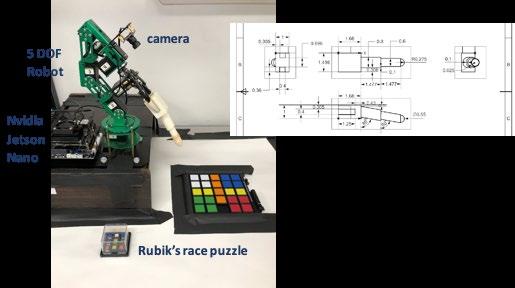
7. Felner, A., Korf, R. E., and Hanan, S., 2004, “Additive pattern database heuristics”. J. Artif. Int. Res. 22, 1 : 279–318
8. URL: https://category.yahboom.net/products/dofbot-jetson_nano
52
Modeling of Atherosclerosis Pathogenesis
 Canidanan Coulibaly and Kazeem Olanrewaju* Department of Chemical Engineering, College of Engineering
Canidanan Coulibaly and Kazeem Olanrewaju* Department of Chemical Engineering, College of Engineering
Introduction:
Cardiovascular system amidst the list of body systems is critical to the survival of organs of itself and other systems. The physiological operation of other systems including the nervous system owes their functionality to the cardiovascular system. Most pathophysiological conditions connected to the circulatory or cardiovascular are paralytic if not often terminal. Alteration in transport of oxygen needed for metabolism by all the body cells and disruption of the metabolic pathway are the major causative mechanisms to most cardiovascular diseases [1-3].
Atherosclerosis, a major pathological precursor to myocardial infarction (deficient supply of oxygen to muscular tissue), is the leading heart disease when connected to the coronary artery [4]. Figure 1 shows artery afflicted by atherosclerosis [5]. It commenced with the damaged to the endothelial cells and transformation of its morphology. The damage endothelial cell layer got fenestrated allowing the transport of low density lipoprotein (LDL) and white blood cells into the intima. The LDL and white blood cells are engage in series of oxidative reaction leading to the accumulation of LDL and dead cells in the affected endothelial layer. This leads to the narrowing of the artery due to hardening of the accumulated species in the inner most layer of endothelial tissue bordering the blood lumen.
Objectives/goals:
The objective of this research is to numerically quantify the various mechanisms involve in the pathogenesis of atherosclerosis and pathophysiological variables leading to its etiology. A flow chart is developed to delineate steps involve species transport and transformation mechanisms leading to atherosclerosis. The specific transport and transformation mechanism is identified and numerical defined to set up the modeling scheme in MATLAB. The physiological effect of these variables as defined in both the transport and transformation mechanistic models are evaluated. The flow chart has been developed and the relevant equations to model the mechanisms are in progress. Numerical experimentation of the causative mechanisms of Atherosclerosis is to offer quantitative insight into diagnostic and therapeutic approach to remediating its etiology
Materials and Methods:
A flow process scheme showing systematically each process involved in species transport and transformation the atherosclerosis pathogenesis will be developed. The various mechanisms defining the transports and transformation processes at each step will be highlighted. The numerical model guiding the transport and transformation mechanisms at each step will be defined. The dependent and independent variables for each of the transport and transformation
53
mechanisms will be harnessed from published data and peer-reviewed literature. The numerical rate scheme for the quantification and analysis of the atherosclerosis pathomechanisms will be developed and solved in MATLAB and COMSOL Multiphysics. MATLAB offers a platform where the matrix and ordinary differential equation solver methods can be directly applied to the numerical rate scheme while the COMSOL Multiphysics chemical engineering module provides user interfaces for developing, probing, and reviewing chemical equations, kinetic rates, and transport equations. The model will be validated based on published in-vivo and in-vitro data. Evaluate the effect of these variables, transport mechanism, and transformation mechanisms on atherosclerosis pathogenesis.
Results and Discussion:
Conclusion:
1st STEP: Flux of Low density Lipoprotein (LDL) across endothelial cell membrane :
Where is the molar flux across the membrane, PLDL specific solute permeability, and are the intima and lumen concentration of LDL, Sm is the membrane surface area, dm is the membrane thickness, partition coefficient, is diffusion coefficient through the membrane.
2nd STEP: Low density lipoprotein (LDL) react with Reactive Oxygen Species (ROS) to Oxidized LDL:
Where k1 is the association rate coefficient, k-1 is the dissociation rate coefficient, OxLDL is the oxidized LDL.
3rd STEP: Leukocytes (LE) binding with endothelial Cell Receptor (ECR):
Where k1 is the association rate coefficient, k-1 is the dissociation rate coefficient, LERC is the leuckocytes-receptor complex
4th STEP: Flux of Leukocytes dissociated from endothelial cell membrane receptor into intima :
Where is the molar flux across the membrane, PLe specific solute permeability, and are the intima and lumen concentration of Le, Sm is the membrane surface area, dm is the membrane thickness, partition coefficient, is diffusion coefficient through the membrane.
5th STEP: Leukocytes now Macrophages (Ma) reacts with Oxidized LDL to form Cell (Fc):
54
Foam Cell promotes migration and accumulation of smooth muscle cell into the intima. The smooth muscle cell is further converted to collagen. Foam cells died and retained within the intima. Accumulation of dead foam cells with collagen leads to the Atherosclerosis.
Impact/Significance:
The study offers the opportunity to study pathogenesis of atherosclerosis in-silico where different scenario leading to the pathophysiological condition can be assessed. The virtual platform can provide insight into the prognosis, diagnosis and to some extent new therapeutic understanding on the remediation of the disease. Student was exposed to the concept of numerical experimentation and various chemical principles that can be applied to studying the pathogenesis of Atherosclerosis.
References:
1. T. Schumacher and R. A. Benndorf, "ABC transport proteins in cardiovascular disease A brief summary," Molecules, vol. 22, (4), pp. 589, 2017.
2. J. Tarbell, M. Mahmoud, A. Corti, L. Cardoso and C. Caro, "The role of oxygen transport in atherosclerosis and vascular disease," Journal of the Royal Society Interface, vol. 17, (165), pp. 20190732, 2020.
3. M. A. Incalza, R. D'Oria, A. Natalicchio, S. Perrini, L. Laviola and F. Giorgino, "Oxidative stress and reactive oxygen species in endothelial dysfunction associated with cardiovascular and metabolic diseases," Vascular Pharmacology, vol. 100, pp. 1-19, 2018.
4. R. O. Darabont, I. S. Vișoiu, Ș L. Magda, C. Stoicescu, V. D. Vintilă, C. Udroiu and D. Vinereanu, "Implications of Myocardial Bridge on Coronary Atherosclerosis and Survival," Diagnostics, vol. 12, (4), pp. 948, 2022.
5. P. Libby, "ATHEROSCLEROSIS: THE NEW VIEW," Sci. Am., vol. 286, (5), pp. 4655, 2002. Available: http://www.jstor.org.pvamu.idm.oclc.org/stable/26059682
55
Activation Energy of Crystallization
of Electrospun Poly (ɛ-Caprolactone) and MgO incorporated Poly (ɛ-Caprolactone) Nanofibers
Daisaku Gicheha and Nabila Shamim*
Department of Chemical Engineering, College of Engineering
Introduction:
The extent of crystallinity in semi-crystalline polymeric scaffolds has been observed to impact various properties, such as surface free energy, wettability, solubility, and degradation behavior [1,2]. However, the extent of thermal treatment can impact the level of crystallinity, chain relaxation, and decrease in chain energy. Furthermore, there has been a notable surge of interest in the crystallization of polymers within confined spaces, as nano-confinement can impede crystal growth and lead to significant deviations in crystallization behavior from that observed in bulk conditions [3,4]. Therefore, understanding the crystal kinetics of polymer nanofibers require fundamental knowledge in crystallization process to control the structures and properties of the final scaffold Differential Scanning Calorimetry (DSC) is used to precisely examine the activation energy of crystallization for bulk-PCL, PCL, and MgO-PCL nanofibers. DSC results were evaluated using STARe software from METTLER TOLEDO. The activation energy of confined polymer in electrospun nanofibers was calculated using the Kissinger and Friedman method.
Materials and Methods:
The electrospinning technique was employed to fabricate the nanofibers, following the methodology outlined in a prior study [5]. The concentration of Poly (ɛ-caprolactone) from Scientific Polymer Products (Mw 70,000 estimated by gel permeation chromatology (GPC}, CAS No # 24980-41-4, Ontario, New York) in the solution was 10 wt.% and 5 wt.% magnesium oxide was incorporated in Poly (ɛ-caprolactone) solution to fabricate MgO-PCL nanofiber composites. Commercial MgO from Sigma Aldrich (CAS No# 1309-48-4) with a particle size less than 50 nm was used in the study.
Results and Discussion:
The crystallization of polymers is controlled by two factors: one is the dynamic factor, which is related to the activation energy ΔE for the transport of crystalline units across the phase, and the other is the static factor which is related to the free energy barrier for nucleation [6]. The Kissinger method is widely used as a way of estimating the activation energy for non-isothermal crystallization studied by DSC. Kissinger’s equation is given as follows [7]:
�������������������������� �������� ���������������� 2�� ���������� 1 ����������������� = ∆�������� �������� (1) 56
where �������� is the cooling rate (K/min), R is the gas constant and Tp is the peak temperature at its maximum value. Using Eq. (1), the Kissinger method can estimate the ΔE from the slope of a straight-line plot ln (�������� /Tp2) versus 1/Tp as shown in Fig. 1 and Table 1. Tianxi Liu et al [8] states that an ΔE is the total activation energy which consists of the transport activation energy that is required to transport molecular segments across the phase boundary to the crystallization surface
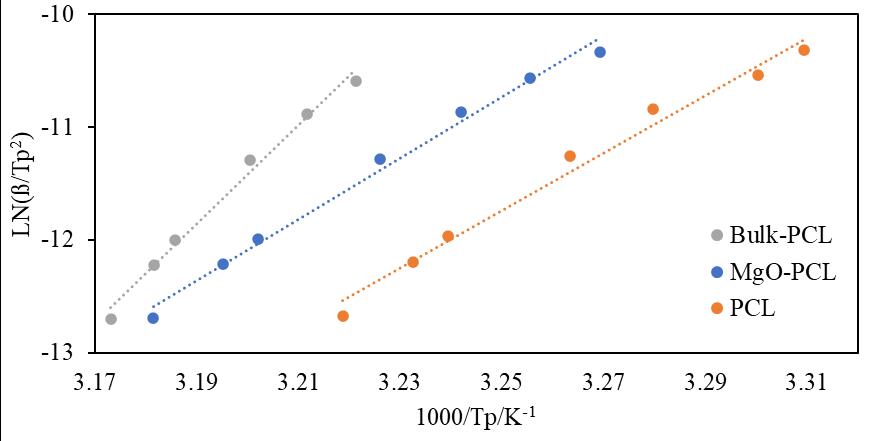
The activation energies of bulk-PCL, PCL, and MgO-PCL nanofibers are -364.74, -212, and -226.3 kJ/mol respectively. MgO-PCL nanofibers (-226.3 kJ/mol) exhibit a slightly lower ΔE than PCL nanofibers (-212 KJ/mol). This indicates that adding 5 wt.% MgO to PCL facilitated the crystallization of PCL molecular chains and boosted crystallization rates due to the nucleation activity of MgO. Furthermore, documented is a rise in Ea with increasing weight fractions of MWCNTs between 0.5 and 5% [9]. Nevertheless, Vyazovkin [10] established in 2002 that the Kissinger equation does not apply to the cooling processes. For melt crystallization, therefore, the differential iso-conversional approach of Friedman (1964) and the integral iso-conversional method of Vyazovkin (2001) are applicable. Due to its dependability and simplicity, the Friedman approach will be utilized in this study [11]. The Friedman equation is expressed as follows:
is the instantaneous crystallization rate as a function of time for a given value of the relative crystallinity (Xt), R is the universal gas constant (J/mol K and ΔEXt is the crystallization activation energy (kJ/mol) that corresponds to crystallization temperature, TXt at various cooling rates. −ΔEXt/R was determined from the slope coefficient plots of ln (dXt/dt) versus 1/TXt, and exhibited a straight line as shown in Fig. 2 at each relative crystallinity. The regression coefficient (R2) has high values which supports the effectiveness of the Friedman
ln ������������������������� ���������������� ����������������� = ���������������������������������������������������������������� ������������������������ RT���������������� (2)
dXt/dt
Samples Ea (kJ/mol) PCL -212.01 MgO-PCL -226.89 Bulk-PCL -364.74
where
Fig.1. Kissinger’s plot for bulk-PCL, PCL and PCL-MgO nanofibers.
57
Table 1. Activation energy values for bulkPCL, PCL, MgO-PCL nanofibers
equation in calculating activation energy for various relative crystallinities.
Fig. 2 was plotted based upon Friedman equation on the reliance of the effective energy on the relative crystallinity. All samples show that the activation energy increases as relative crystallinity increases. This suggests that the polymer difficulty of crystallization increases as the relative crystallinity increases. Activation energy for all samples follows the order: PCL nanofibers > MgO-PCL nanofibers > Bulk-PCL. Both nanofibers have a higher activation energy than bulk-PCL, suggesting that crystallinity is reduced due to nanoconfinement of the nanofibers. Also, as relative crystallinity increases, temperature reduces, and activation energy increases. Therefore, crystallization ability becomes harder as the temperature reduces. Freidman equation proves to be accurate as Kissinger’s activation energy equation as shown in Table 1, provides the same result. Therefore, the higher the activation energy, the lower the crystallization ability and vice versa [12] The results clearly indicated that the composite nanofibers with 5 wt.% MgO presented lower activation energy than PCL nanofibers. A similar trend of activation energy was observed for clay loading on PBT for the isothermal and non-isothermal crystallization process [13].
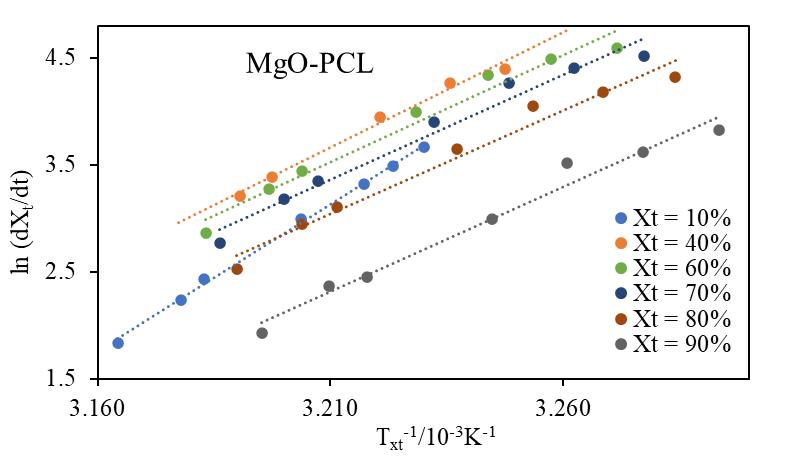
Conclusion: DSC was used to evaluate the activation energy of crystallization of PCL and MgO-PCL at varied cooling rates. Friedman's approach determined the Ea values for bulk PCL, PCL
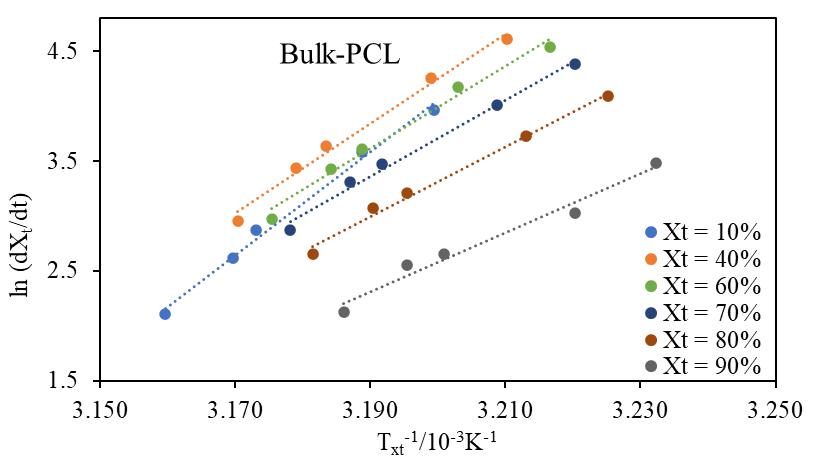
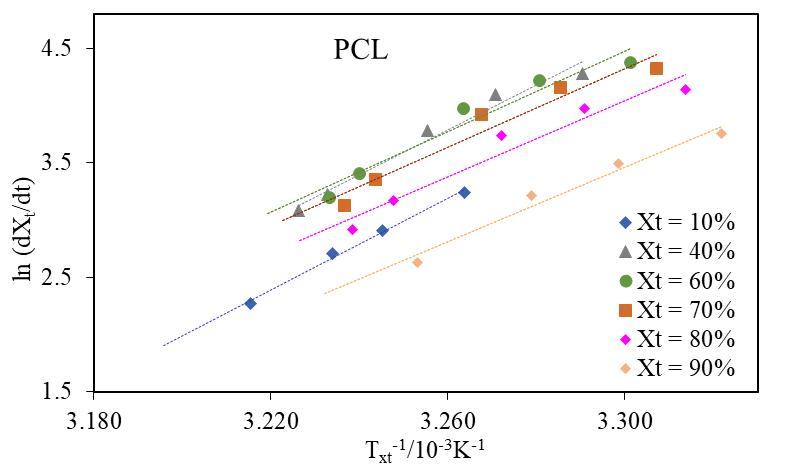 Fig.2. Plots ln(dXt/dt) versus 1/Txt of PCL nanofiber at different relative crystallinities for PCL, MgO-PCL and Bulk-PCL.
Fig.2. Plots ln(dXt/dt) versus 1/Txt of PCL nanofiber at different relative crystallinities for PCL, MgO-PCL and Bulk-PCL.
58
nanofibers, and MgO-PCL nanofibers. As necessary energy is lost during crystallization from a melt, the activation energy is negative. Since the Ea value of nanofiber is larger than that of bulk PCL, this shows that nanoconfinement makes it more difficult to transfer PCL chain segments to develop crystals.
Impact/Significance:
The study of activation energy of crystallization of nanofibers is important to understand the development of crystalline structures. It is crucial to comprehensively examine the internal structure of polymeric nanofibers to enhance their efficiency, a domain that has yet to be extensively explored.
References:
1. Molina, M.I.E.; Malollari, K.G.; Komvopoulos, K. Design Challenges in Polymeric Scaffolds for Tissue Engineering. Front. Bioeng. Biotechnol. 2021, 9, 617141.
2. Calore, A.R.; Srinivas, V.; Anand, S.; Albillos-Sanchez, A.; Looijmans, S.F.S.P.; van Breemen, L.C.A.; Mota, C.; Bernaerts, K.; Harings, J.A.W.; Moroni, L. Shaping and properties of thermoplastic scaffolds in tissue regeneration: The effect of thermal history on polymer crystallization, surface characteristics and cell fate. J. Mater. Res. 2021, 36, 3914–3935
3. Ma, Q.; Pyda, M.; Mao, B.; Cebe, P. Relationship between the rigid amorphous phase and mesophase in electrospun fibers. Polymer (Guildf.) 2013, 54, 2544–2554.
4. Arinstein, A. Confinement mechanism of electrospun polymer nanofiber reinforcement. J. Polym. Sci. Part B Polym. Phys. 2013, 51, 756–763.
5. Khandaker, M.; Progri, H.; Arasu, D.T.; Nikfarjam, S.; Shamim, N. Use of polycaprolactone electrospun nanofiber mesh in a face mask. Materials (Basel) 2021, 14, 4272.
6. Chafidz, R. Ali. S.E. Al-Zahrani, "Atomic Force Microscopy, thermal, viscoelastic and mechanical properties of HDPE/CaCO3 nanocomposites," Journal of Polymer Research, vol. 9860, no. 4, p. 19, 2012.
7. S. Vyazovkin, "Kissinger Method in Kinetics of Materials: Things to Beware and Be Aware of," Molecules, vol. 25, 2020.
8. T. Liu, Z. Mo, H. Zhang, "Isothermal and nonisothermal melt crystallization kinetic behavior of poly(aryl ether biphenyl ether ketone ketone): PEDEKK," Journal of Polymer Engineering, vol. 18, pp. 283-299, 1998.
9. N. Coburn, P. Douglas, D. Kaya, J. Gupta, T. McNally, "Isothermal and non-isothermal crystallization kinetics of composites of poly(propylene) and MWCNTs, Advanced Industrial and Engineering Polymer Research.," vol. 1, pp. 99-110, 2018.
10. S. Vyazovkin, "Is the Kissinger Equation Applicable to the Processes that Occur on Cooling," Macromol, vol. 23, pp. 771-775, 2002.
11. S. Vyazovkin, "Modification of the integral isoconversional method to account for variation in the activation energy," J. Comput. Chem., vol. 22, pp. 178-183, 2001.
12. P. Supaphol, N. Dangseeyun, P. Srimoaon, "Non-isothermal melt crystallization kinetics for poly(trimethylene terephthalate)/poly(butylene terephthalate) blends.," Polym. Test., vol. 23, pp. 175-183, 2004.
13. Al-Mulla, J. Mathew, S.-K. Yeh, R. Gupta, "Nonisothermal crystallization kinetics of PBT nanocomposites," Compos. Part A Appl. Sci. Manuf., vol. 39, pp. 204-217, 2008.
59
Juvenile Justice and Psychology
Accessing African Centered Cultural Programs in English Prisons
Zian Richmond and Sally-Ann Ashton*
Texas Juvenile Crime Prevention Center, College of Juvenile Justice
Introduction:
In England, Black and minority prisoners have been overrepresented at all levels of the Criminal Justice System (Lammy, 2017). They experience systemic racism in their sentencing, supervision, and progression, with many HM Prison and Probation reports identifying individual stereotyping and discrimination by staff. African, Black British, and Caribbean prisoners are the largest ‘minority’ ethnicized group in English prisons. The research will assist with understanding the following (quotes from prisoners as cited in Ashton, 2008):
1. That having access to a positive and critical history can impact on how prisoners view themselves and their potential. “If you feel inferior to someone, but then someone is telling you [in Black history classes] hold on a minute you’re not… Your confidence goes up… Your people have done that.” (Black British male prisoner 23 years old).
2. That many Black British prisoners believe their culture and behavior is often misunderstood by non-Black members of staff: “Sometimes, it’s misunderstood because when I speak to a female member of staff about something that I’m passionate about, I talk, I use my hands, I’m very vibrant and then you see one member of staff coming, and another, and I think, hold on, I’m doing nothing. They look at it as a form of aggression, they don’t understand our culture, it’s the way we communicate. They think, there’ll be a fight in a minute.” (Black British male prisoner 37 years old).
The project utilized existing data that was collected over a 5- year period as part of an outreach program in English prisons. Data were collected to explore the impact of Black Cultural Awareness workshops, allowing incarcerated communities and prison staff to explore history, identity, and racism in a prison environment. Data are in the form of pre and post session questionnaires given to staff and prisoners who attended a program to explore Black History and Black British community experiences of imprisonment.
Objectives/goals:
1. To understand the impact of accessing culturally specific programs on prisoners of African, Black British, and Caribbean descent.
2. To explore the impact of attending Black cultural programs on prison staff.
Materials and Methods:
Stage 1 of the project is to transfer data from paper to SPSS. The following were reported: age, prison sentence (inmate) or length of service (staff) racialized and ethnicized identity, cultural
60
contact; 6 questions relating to Black culture and history before and after the session; a free text section relating to the workshop.
Stage 2 involved a one-way between groups analysis of variance was conducted to explore responses scores for attitudes to Black British experiences of imprisonment according to role within the prison (uniformed staff, support staff, prisoners); and according to connection to Black British culture (self-identified as Black British, friends, no association with Black British culture).
Results and discussion:
Table 1 demonstrates significant variance between the uniformed staff and both support staff and prisoners regarding if they learned something new, if BCA is important to their job and or prison, if it’s important to know about black history, and if they believed prison is more negative for black people than white people. The results suggest that uniformed staff may require additional training to support their understanding of the challenges facing Black British inmates. The attitude of uniformed staff (predominantly prison guards) to learning and understanding the impact of imprisonment on communities who have experienced racism was significantly different compared to support staff and the prisoners. This is concerning because uniformed staff have the most contact with prisoners and would be a first point of contact for accessing services and pastoral support.
ª Equal variances not assumed (on basis of Levene’s test for equality of variance), Games Howell comparison
Significance *p< .05; **p< .01; ***p< .001
Effect size *Small, **Medium, ***Large
After N M SD F p Eta squared ANOVA ANOVA 1 Uniform staff Support staff Prisoners 44 9 24 4.89 5.67 5.71 1.22 0.71 0.81 5.50 a .01* .13*** < support < prisoners 2 Uniform staff Support staff Prisoners 45 10 25 5.24 5.70 5.64 0.93 0.48 0.95 5.39 a .01* .12*** < support < prisoners 3 Uniform staff Support staff Prisoners 45 10 25 5.00 5.80 5.92 1.30 0.42 0.28 8.53 a .001** .18*** < support < prisoners 4 Uniform staff Support staff Prisoners 45 9 25 3.44 5.33 5.40 1.59 0.50 0.96 20.46 a .001** .35*** < support < prisoners 5 Uniform staff Support staff Prisoners 45 10 25 29.31 33.90 33.88 4.58 2.47 2.59 13.92 a .001** .27*** < support < prisoners
Table 1 ANOVA summary showing significant variance according to role after the training
61
1. Learned something new
2. I feel that cultural awareness training is relevant to my job/being in prison
3. I think it is important to know about Black history
4. I believe that prison can be a more negative experience for Black people compared to white people
5. Total score
Table 2 shows that there was a significant variance in impact of the program according to whether participants had any association with Black British culture, (self-identified, friends, or no connection). The items where variance was found were: BCA is relevant to their job and or prison, it is important to know Black history, and prison is more negative for Black people compared to other racialized groups. The results emphasize the difference in the level of understanding of the experiences of incarcerated Black British community members after the program. Results varied depending on how participants were connected, if connected at all, to black British culture. Having friends who were racialized as Black did not appear to impact on the level of understanding. These findings suggest that all staff members who did not selfidentify as Black British required additional training to fully understand the experiences and problems faced by Black prisoners.
ª Equal variances not assumed (on basis of Levene’s test for equality of variance), Games Howell comparison.
Significance *p< .05; **p< .01; ***p< .001
Effect size *Small, **Medium, ***Large
After N M SD F p Eta squared ANOVA ANOVA 1 Friends Self No connect 44 27 10 5.43 5.89 5.00 0.87 0.42 1.56 4.40 a .02* .10*** < self < self < friends 2 Friends Self No connect 44 27 10 5.14 5.93 5.00 1.15 0.27 1.56 5.83 a .004** .13*** < self 3 Friends Self No connect 44 26 10 3.72 5.31 4.00 1.59 1.12 1.70 9.65 .001** .20*** < self 4 Friends Self No connect 44 27 10 30.23 33.89 30.20 4.64 2.68 4.47 7.31 a .001** .16*** < self
Table 2 ANOVA summary showing significant variance according to association to Black British culture after the training
62
1. I feel that cultural awareness training is relevant to my job/being in prison
2. I think it is important to know about Black history
3. I believe that prison can be a more negative experience for Black people compared to white people
4. Total score
Impact/Significance:
The research has emphasized significant variance in how some prison staff perceive the experiences of incarcerated Black communities. It has also shown that diversity equality and inclusion training to be tailored depending on the role of prison staff members.
References:
1. Ashton, S-A. (2008). The impact of cultural heritage programmes on the self-concept of Black male prisoners in England. Unpublished MPhil thesis. University of Cambridge.
2. Lammy D (2017) The Lammy Review: An Independent Review into the Treatment of, and Outcomes for, Black, Asian and Minority Ethnic Individuals in the Criminal Justice System. London: Lammy Review. National Audit Office (2016) Transforming Rehabilitation.
63
Medical Academy
Development of Biodegradable and Biocompatible polymer-based scaffolds for Tissue Engineering
Emily Irikannu and Naznin Sultana*
The Texas Undergraduate Medical Academy
Introduction:
Tissue engineering seeks to create artificial tissues that can replace diseased/damaged tissue using biomaterials. Biomaterials are defined as a substance that is created to take place in a complex system, such as tissue scaffolds. Additionally, scaffolds require a three-dimensional structure and must be porous to allow the growth of surrounding tissues into the implant. Scaffolds can be composed of biocompatible polymers which can add degradable properties. These polymers are often used because of their biodegradable quality, processing efficiency, and biological and chemical properties similar to the extracellular matrix in tissue (Kirillova et al., 2021). Polysaccharides such as pectin and chitosan are favorable for these applications because they form polyelectrolyte complexes, which reduce potential toxicity (Bombaldi de Souza et al., 2019). Tissue engineering is becoming increasingly important because of the growing need for human tissues and organs (Israni et al., 2020). The use of these scaffolds can be essential in treating patients that suffer from damaged tissues as a less invasive treatment.
Materials and Methods:
Preparation of Scaffolds: Sigma brand chitosan (0.5g) and 0.05 g of Sigma brand pectin were weighed out and placed into a small beaker. 10 mL of 2% Acetic Acid was placed into the beaker. The beaker was then stirred on a magnetic stirrer until the solution was clear, then evenly distributed between two small glass tubes and covered with aluminum foil. The samples were placed in a –18º C freezer, then freeze-dried in a Labconco Freeze Dryer.
Physical Characterization: After retrieving the scaffolds from the freeze dryer, they were removed from the glass container. Once the diameter, length, and mass were measured, the density and volume were calculated. The water uptake was measured by placing a piece of the scaffold in PBS solution.
Cell Culture: Human skin fibroblasts (HSF) cells were grown in a T-flask until confluence was observed. The cells in the T-flask were seeded on the scaffolds in a 24-well plate using cell mediums. The well plate was observed under a microscope.
64
Results and Discussion:
This process successfully created three-dimensional tissue scaffolds with a porous structure (Fig 1 and Fig. 2). The freeze-drying process achieved a uniform pore morphology with a complex scaffold arrangement (Capuana et al., 2021). The water uptake of the scaffolds was 1,083.7% for pure chitosan, 900.7% for 0.5g chitosan with 0.05g pectin, and 1,142.4% for 0.5g chitosan with 0.1g pectin. HSF cells successfully grew on the scaffolds in vitro (Fig. 3). Table 1 shows the physical properties and wateruptake of different types of scaffolds.
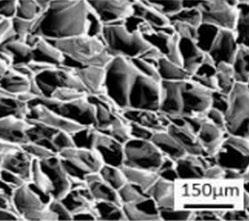
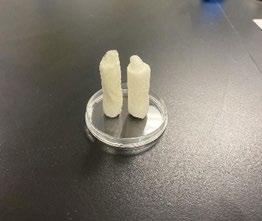
Conclusion:
Because of the high-water uptake, porosity, and growth of cells on this tissue scaffold, it has high promise for tissue engineering. Scaffolds composed of biomaterials are stable when degraded in a culture medium, and lack cytotoxicity (Bombaldi de Souza et al., 2019). Previous studies have indicated that implanted scaffolds have promising immune responses and amplify internal tissue regeneration (Zhu et al., 2019). Further directions for this study could be implanting the scaffold in vivo to test the effects.
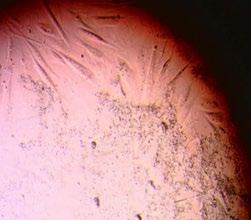
Sample Polymer Composition Height (cm) Diameter (cm) Radius (cm) Volume (cm^3) Density (g/cm^3) Concentration (g/ml) Water uptake (%) 1 0.5g Chitosan 4.75 1.4 0.70 7.41 0.035 2.5 1,083.7 2 0.5g Chitosan, 0.05g Pectin 3.55 1.1 0.55 3.374 0.05145 2.75 900.7 3 0.5g Chitosan, 0.1g Pectin 4.1 1.4 0.7 6.31 0.0386 3 1,142.4
Figure 1. 3D scaffolds. Figure 2. Porous structure of scaffolds. Figure 3. Growth of HSF cells on scaffold.
Table 1. Physical characterization table.
65
References:
1. A.K. Israni, D. Zaun, N. Hadley, J.D. Rosendale, C. Schaffhausen, W. McKinney, J.J. Snyder, B.L. Kasiske (2020). OPTN/SRTR 2018 Annual Data Report: Deceased Organ Donation, American Journal of Transplantation, Volume 20, Supplement 1,
2. Alina Kirillova, Taylor R. Yeazel, Darya Asheghali, Shannon R. Petersen, Sophia Dort, Ken Gall, and Matthew L. Becker (2021) Fabrication of Biomedical Scaffolds Using Biodegradable Polymers
3. Capuana E, Lopresti F, Carfì Pavia F, Brucato V, La Carrubba V. Solution-Based Processing for Scaffold Fabrication in Tissue Engineering Applications: A Brief Review. Polymers. 2021; 13(13):2041. https://doi.org/10.3390/polym13132041
4. Comparative study on complexes formed by chitosan and different polyanions: Potential of chitosan-pectin biomaterials as scaffolds in tissue engineering, International Journal of Biological Macromolecules, Volume 132, 2019, Pages 178-189, ISSN 0141-8130
5. Fernanda Carla Bombaldi de Souza, Renata Francielle Bombaldi de Souza, Bernard Drouin, Diego Mantovani, Ângela Maria Moraes,
6. Lee EJ, Kasper FK, Mikos AG. Biomaterials for tissue engineering. Ann Biomed Eng. 2014 Feb;42(2):323-37. doi: 10.1007/s10439-013-0859-6. Epub 2013 Jul 3. PMID: 23820768; PMCID: PMC3844045
7. Naznin Sultana, Masturah Mokhtar, Mohd. Izzat Hassan, Rashid Mad Jin, Fatemeh Roozbahani & Tareef Hayat Khan (2015) Chitosan-Based Nanocomposite Scaffolds for Tissue Engineering Applications, Materials and Manufacturing Processes, 30:3, 273-278
8. Zhu, M., Li, W., Dong, X. et al. In vivo engineered extracellular matrix scaffolds with instructive niches for oriented tissue regeneration. Nat Commun 10, 4620 (2019).
https://doi.org/10.1038/s41467-019-12545-3
66
Nursing
The Relationships Among Child Sexual Abuse, Psychosocial Outcomes, and Mental Health Burden: A Literature Review
Mona Hassan* College of Nursing
Introduction:
Child abuse is a widespread social problem that negatively affects victims, families, communities, and society. According to United Nations International Children's Emergency Fund (UNICEF) children who live with and are aware of violence in the home face many challenges and risks that can last throughout their lives. Children who are affected by domestic violence have an increased risk of becoming victims of abuse. Child protection authorities are being involved more routinely in domestic violence cases, which has led to a variety of interventions, including removing the child from the home (Unicef, 2020). Violence is always destructive and is often repeated creating a vicious cycle. Adult victims of violence often reported experiencing the same type of violence or abandonment that their mothers once faced, and as recalled from their childhood. The study revealed that intra-family violence is often transmitted from one generation to the next, leaving an abundance of emotional and physiological trauma that is later expressed for the duration of a lifetime (Tardivo & Barrientos, 2018).
Some researchers have posited that the primary complications of the CSA are sexually compulsive behaviors (Meyer, Cohn, Robinson, Muse & Hughes, 2017), alcohol and substance misuse (Wilhite, Mallard & Fromme, 2018; Hailes, Yu, Danese & Fazel, 2019). Posttraumatic stress disorder (Görg, et al., 2017; Hailes, Yu, Danese & Fazel, 2019), suicidal ideation/attempts/behaviors (Cantón- Cortés, Cortés & Cantón, 2020; Wong, Kuo, Sobolewski, Bhatia & Ip, 2020), and self-injury and violence (Taliaferro, McMorris, Rider & Eisenberg, 2019) are also commonly reported. The research question is What are the Psychosocial Outcomes, and Mental Health Burden of the CSA?
Materials and Methods:
A systemic review method will be used to address the aim of this study. A systematic review is the summation and assessment of research studies, documented in the literature, which is based on a focused question that uses organized and explicit methods to identify, select, critically appraise, and analyze relevant data from the literature (Lobiondo & Haber, 2018). This method was chosen because they help to facilitate an efficient and scientific approach that is needed to carefully address the aim of this proposed study (Lobiondo & Haber, 2018).
67
We identified the relevant articles published from inception May 25, 2017 to August 2021, through a systematic search of selected databases, all of which are available through the Internet and other resources available at the University. Two databases will be the primary sources for the literature searches: EBSCO, CINAHL Plus with Full-Text, 2017-Current, and PubMed central 2017-Current and Searches will begin around June 15th and end on August 30th, 2021. Search terms will be generated by the entire research team, consisting of one researcher and two research assistants. The preliminary set of subject headings will be identified using the selected electronic bibliographic databases. Then, records from each literature search will be scanned for each subject heading and keywords will be identified from the research document. The resulting list will be reviewed, corrected, and completed by the research team. The expertise of an external consultant will be used to verify and validate the search results. Research strategies such as controlled vocabular y (where available) and free-text terms representing the major concepts contained in the review topic, will be used. Extracted terms will be combined. Here is an example Title: Child OR Children* OR “school age ” OR Kid* AND “sexual abuse” OR “sexual harassment” OR “sexual assault” OR “sexual victim” AND complications OR problem* OR difficulties OR worries OR barriers OR obstacles OR concern* OR obstructions and so forth. Searches will be limited to full articles, school age children and adolescents, English language publications. The date limits will be from May 2017June to August 2021. All behavioral health and mental health, child and adolescent focused journals and scientific reports will be included in the search (2017- current).
Results and Discussion:
The preliminary results were presented at the PVAMU Faculty research day in April 2023. Some researchers have posited that the primary outcomes of CSA are sexually compulsive behaviors, unhealthy sexual ideations, and behaviors such as a lack of sexual satisfaction and an increased sense of anxiety about their sexual performance (Rellini & Meston, 2022; Meyer et al., 2018). Also included are altered emotional perceptions (Williams et al., 2019). mental illnesses, learning disabilities, and physical disabilities (Katuwal et al., 2021; Vézina-Gagnon et al., 2020; Fleischer et al., 2021; Chen et al., 2019; Belete et al., 2020). Other findings suggest engaging in cigarette, alcohol, marijuana, and inhalant use and abuse (Karamouzian & Hayashi, 2020; Prangnell et al., 2020), Post-traumatic disorders (Bainter et al., 2019), suicidal ideation/attempts/behaviors (Sigurvinsdottir et al., 2021), and self-injury and violence (Isumi et al., 2020; Katuwal et al., 2021). The manifestation of the long-term effects of CSA is extensive and intensive. More mental health services are needed.
References:
1. Cantón-Cortés, D., Cortés, M. R., & Cantón, J. (2020). Child Sexual Abuse and Suicidal Ideation: The Differential Role of Attachment and Emotional Security in the Family System. International journal of environmental research and public health, 17(9), 3163. https://doi.org/10.3390/ijerph17093163
2. Goodyear-Brown, P. (Ed.). (2012). Handbook of child sexual abuse: Identification, assessment, and treatment. John Wiley & Sons.
3. Grove, S. K., & Cipher, D. J. (2017). Statistics for nursing research (2nd ed.). Elsevier.
68
4. Hailes, H. P., Yu, R., Danese, A., & Fazel, S. (2019). Long-term outcomes of childhood sexual abuse: an umbrella review. The lancet. Psychiatry, 6(10), 830–839.
https://doi.org/10.1016/S2215-0366(19)30286-X
5. Hassan, M. A., Gary, F., Killion, C., Lewin, L., & Totten, V. (2015). Patterns of sexual abuse among children: Victims’ and perpetrators’ characteristics. Journal of Aggression, Maltreatment & Trauma, 24(4), 400–418.
6. Hassan, M., Killion, C., Lewin, L., Totten, V., & Gary, F. (2015). Gender-related sexual abuse experiences reported by children who were examined in an emergency department. Archives of Psychiatric Nursing, 29(3), 148–154.
7. Unicef.org. (2020). The impact of domestic violence on children. Retrieved from https://www.unicef.org/media/files/BehindClosedDoors.pdf.
69



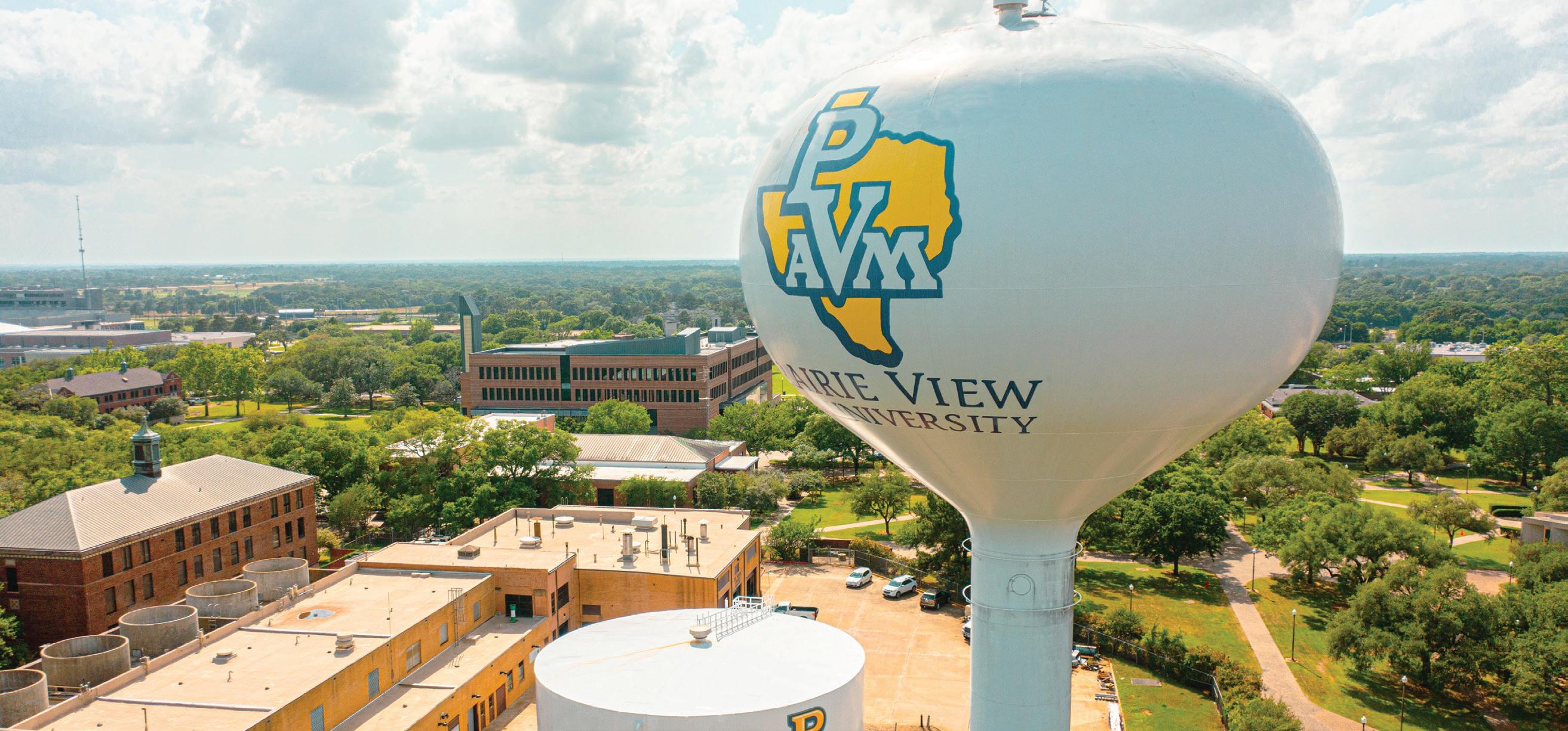
RESEARCH & I N N O V A TI O N RESEARCH@PVAMU.EDU WWW.PVAMU.EDU/RESEARCH THANK YOU






 Figure 2. 24 hours following the Keratitis infection, an photograph of the ocular surface revealed the presence of infective infiltrate. For analysis purposes of the ocular infection, the area in question was magnified and ImageJ allowed for direct focus and emphasis on the infective area.
Figure 2. 24 hours following the Keratitis infection, an photograph of the ocular surface revealed the presence of infective infiltrate. For analysis purposes of the ocular infection, the area in question was magnified and ImageJ allowed for direct focus and emphasis on the infective area.





 Carlos Ridley and Kevin Storr*
Carlos Ridley and Kevin Storr*















 Canidanan Coulibaly and Kazeem Olanrewaju* Department of Chemical Engineering, College of Engineering
Canidanan Coulibaly and Kazeem Olanrewaju* Department of Chemical Engineering, College of Engineering



 Fig.2. Plots ln(dXt/dt) versus 1/Txt of PCL nanofiber at different relative crystallinities for PCL, MgO-PCL and Bulk-PCL.
Fig.2. Plots ln(dXt/dt) versus 1/Txt of PCL nanofiber at different relative crystallinities for PCL, MgO-PCL and Bulk-PCL.





